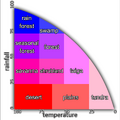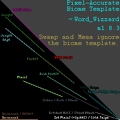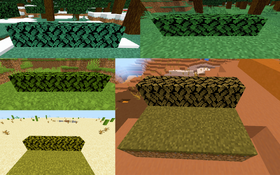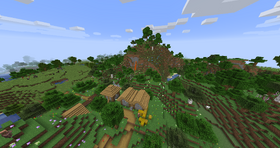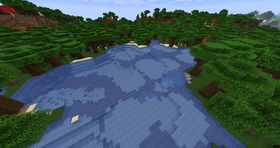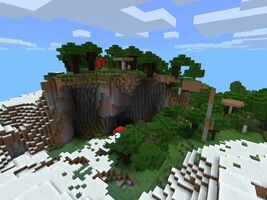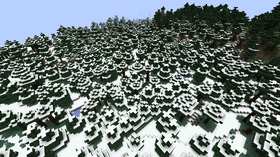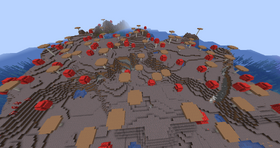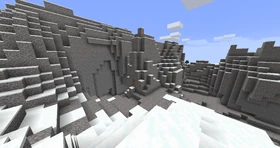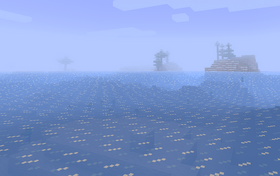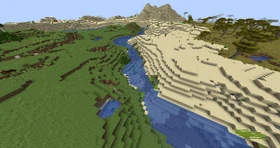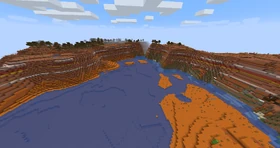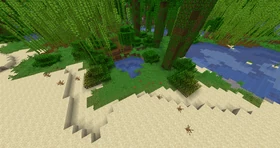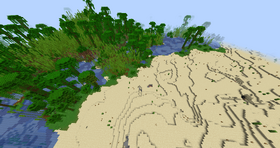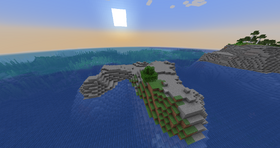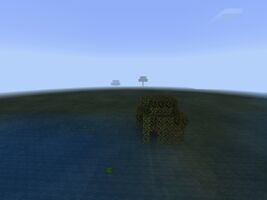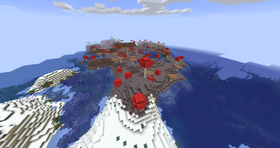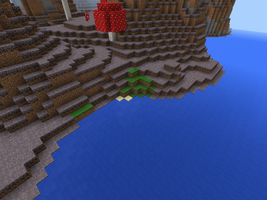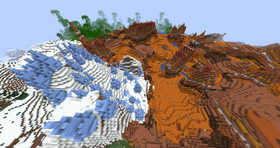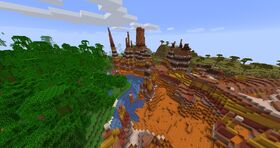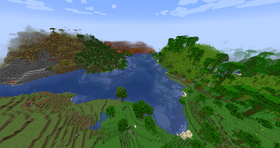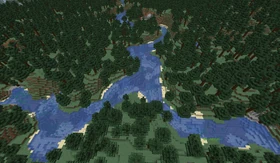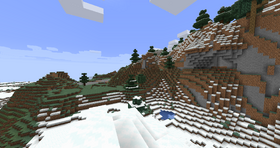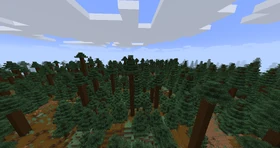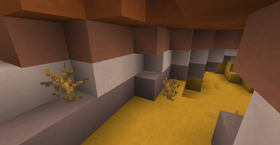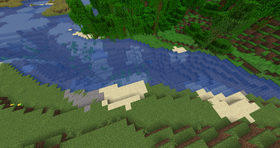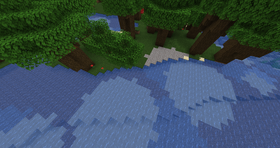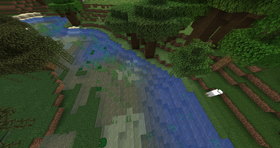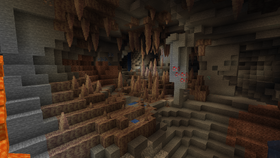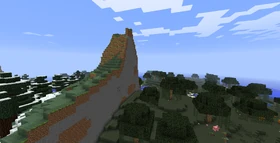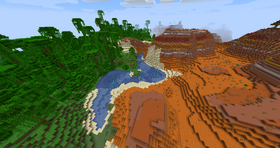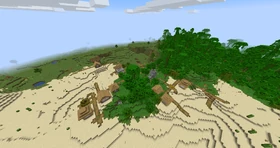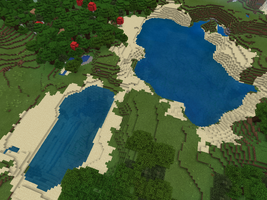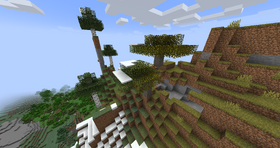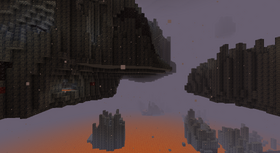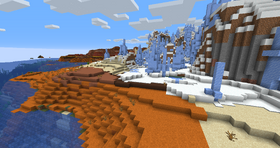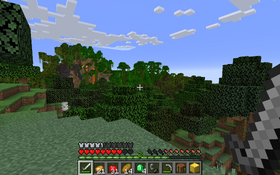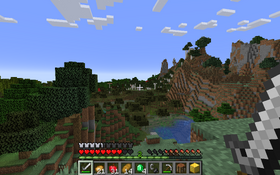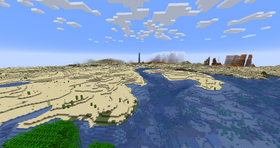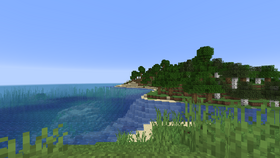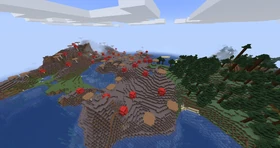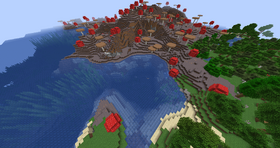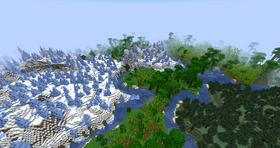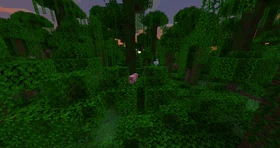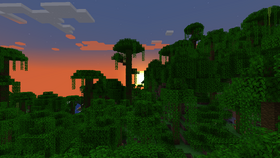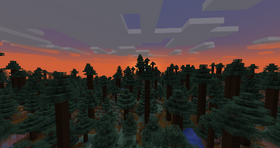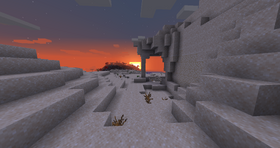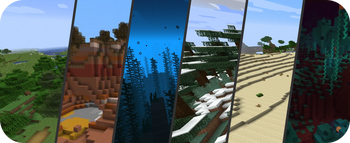
Minecraft contains different biomes which can be traveled to.
A biome is a region in a world with distinct geographical features, flora, temperatures, humidities, and sky, water, fog, grass and foliage colors. Biomes separate every generated world into different environments, such as forests, deserts and taigas.
The biome of a location is determined during world generation rather than current environment. Even if the player completely changes all the blocks in a large area to imitate the terrain of other biomes, the biomes in this area will not be affected. However, in Java Edition, the /fillbiome command can change the biome in an area.
Biomes can be located using the /locate biome command.
List of biomes[]
Biome types[]
In Java Edition, there are 64 different biome types: 53 for the Overworld, 5 for the Nether, and 5 for the End, plus one used only for a superflat preset. In Bedrock Edition there are 86 biome types: 53 for the Overworld, 5 for the Nether, 1 for the End, and 27 unused.
On this page, for convenience of description and reading, the biomes in Overworld are divided into 8 categories, which are not official. While in each category, biomes may be further divided into some sub-categories. Biomes in a sub-categories are placed in one page, such as plains and sunflower plains, and are described as variants on this wiki.
Overworld[]
Offland biomes[]
These biomes are used for the generation of oceans and mushroom fields. They are large, open biomes made entirely of water going up to y=63, with underwater relief on the sea floor, such as small mountains and plains, usually including gravel. Squid and fish spawn frequently in the water.
These biomes are further divided into three categories: Oceans, Deep Oceans, and Mushroom Fields.
| Biome name | Description | Screenshot |
|---|---|---|
Ocean |
The basic Ocean biome. Like its colder variants, its floor is made up of gravel. Sea grass, kelp, cod and salmon[Bedrock Edition only] can spawn here. |
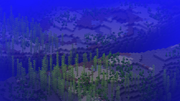 Ocean |
Deep Ocean |
A variant of the Ocean biome. In Deep Ocean biomes, the ocean can exceed 30 blocks in depth, making it twice as deep as the normal ocean. The ground is mainly covered with gravel. Ocean monuments generate in deep oceans, meaning guardian and elder guardian can spawn here. Underwater ravines often generate here, with the top layer of lava being replaced by magma blocks that create bubble columns. |
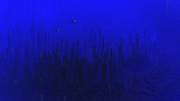 Deep Ocean |
Warm Ocean |
A variant of the Ocean biome, with light teal water at the surface. Like the Lukewarm Ocean, it has a floor made of sand, and like all oceans, it is populated with seagrass. Unlike other ocean biomes, Warm Oceans allow for the generation of coral reefs and sea pickles. Kelp cannot spawn here. It is the only ocean biome that does not have a deep variant. |
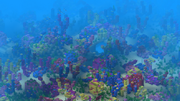 Warm Ocean |
Lukewarm Ocean |
A variant of the Ocean biome, with light blue water at the surface. Its floor is made of sand with the occasional dirt or clay, kelp and seagrass spawn here. Unlike the Warm Ocean biome, cod and salmon[BE only] can spawn here. Coral cannot spawn here. |
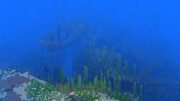 Lukewarm Ocean |
Deep Lukewarm Ocean |
Similar to the Lukewarm Ocean biome, but twice as deep. Because they are a Deep Ocean variant, they can generate ocean monuments, resulting in the spawning of guardians, elder guardians, prismarine, and sponges. |
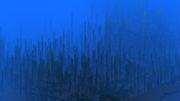 Deep Lukewarm Ocean |
Cold Ocean |
A variant of the Ocean biome, with dark blue water at the surface. Like the standard Ocean and Frozen Ocean biomes, its floor is made up of gravel, though occasional patches of dirt can be found. Salmon are able to spawn in Cold Ocean biomes. |
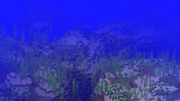 Cold Ocean |
Deep Cold Ocean |
Similar to the Cold Ocean biome, but twice as deep. Like other Deep Oceans, ocean monuments are able to generate here, which contain guardians, elder guardians, prismarine, and sponges. |
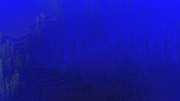 Deep Cold Ocean |
Frozen Ocean |
A variant of the Ocean biome with dark indigo water at the surface. Like the Cold Ocean, it has a gravel seabed and squids swimming about. However, the water's surface is frequently broken up by patches of ice and large icebergs, consisting of packed ice and, occasionally, blue ice. Strays and polar bears can spawn here, but dolphins do not. |
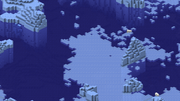 Frozen Ocean |
Deep Frozen Ocean |
Like the frozen ocean biome, the only fish that spawn here are salmon and cod,[BE only] and the floor consists of gravel. The frozen deep ocean biome also contains ocean monuments and a deeper floor than normal oceans, like other deep oceans. Frequent floating icebergs with blue ice generate here. Polar bears, rabbits, and strays can also spawn here, but dolphins do not. |
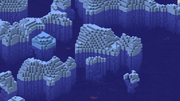 Deep Frozen Ocean |
Mushroom Fields |
This rare biome consists of a mostly flat island and has mycelium instead of grass as its surface. However, any grass placed appears in a bright green color, even brighter than in the jungle. Mushroom fields are always adjacent to a deep ocean and are isolated from other biomes, and they are typically a few hundred blocks wide. It is one of the few biomes where huge mushrooms can generate naturally, and where mushrooms can grow in full sunlight. No mobs other than mooshrooms spawn naturally in this biome, including the usual night-time hostile mobs. This also applies to caves, mineshafts, and other dark structures, meaning exploring underground is safe. However, monster spawners still spawn mobs, wandering traders along with their llamas can spawn, raids can still spawn illagers, the player can still breed animals and spawn mobs using spawn eggs, and insomnia still attracts phantoms. |
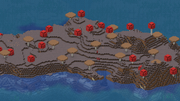 Mushroom Fields |
Highland biomes[]
Highland biomes are biomes with high Y-level, rugged terrain, and snow-covered peaks appear above the snow line.
These biomes are further divided into two categories: Mountains and Windswept Hills.
| Biome name | Description | Screenshot |
|---|---|---|
Jagged Peaks |
One of the three biomes that generate in the peaks of a mountain. This biome is found in taller and more jagged and pointy peaks that often pass the clouds and can peak at y=256. It is covered by a single layer of snow blocks with stone underneath often exposing ores such as coal, iron and emerald, and just like the snowy slopes, stone cliffs can generate in some sides of the mountain. Only goats spawn in this biome. |
 Jagged Peaks |
Frozen Peaks |
The frozen peaks are covered by snow blocks and packed ice with occasional small blobs of ice. This biome usually generates in smoother and less jagged mountains compared to the jagged peaks biome. Only goats can spawn in this biome. |
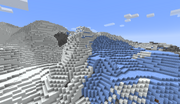 Frozen Peaks |
Stony Peaks |
The stony peaks are a warmer variation of peak biomes that generates in warmer regions to avoid temperature clashes. It is mainly covered by stone with large strips of calcite and exposed ores. No passive mobs spawn in this biome, and there's no snow. |
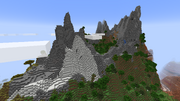 Stony Peaks |
Meadow |
The meadow is an elevated grassy biome found in plateaus near mountain ranges. It is filled with patches of flowers and turquoise-green grass and tall grass. All small flowers generate except Blue orchids, tulips, lilies of the valley or wither roses. Rarely, a lone oak or birch tree can generate and always has a bee nest. Both pillager outposts and plains villages can generate in this biome. Sheep, donkeys and rabbits are the only passive mobs that spawn in this biome. |
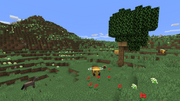 Meadows |
Cherry Grove |
Cherry groves are grasslands with a lot of grass, tall grass and, besides the traditional dandelions and poppies flowers, there are pink petals. The main environmental feature of the cherry grove are cherry trees identified by their striking pink color. Their leaves drop petal particles. The cherry trees may generate densely enough create a cover of leaves. The cherry grove biome is good for surviving. The sparseness of trees can help the player not to get lost while collecting a great abundance of resources. |
 Cherry Grove |
Grove |
The grove creates a forest of spruce trees beneath the mountain peaks when near a forested biome. It is quite reminiscent of the snowy taiga but the surface is covered with snow layers, snow blocks, dirt and a lot of powder snow instead of grass blocks. Rabbits, wolves and foxes can spawn in this biome. |
 Grove |
Snowy Slopes |
The snowy slopes generate on beneath the mountain peaks and are covered multiple layers of snow blocks and powder snow, with some sides also having stone cliffs. Goats spawn in this biome alongside rabbits. This is the only mountain biome where igloos can generate, making it one of the three biomes where igloos naturally generate. |
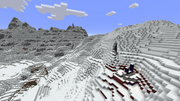 Snowy Slopes |
|
A highland biome with some steep hilltops. Cliffs, peaks, valleys, waterfalls, overhangs, floating islands, caverns and many other terrain features exist here, offering outstanding views. This is one of the few biomes where llamas can spawn naturally. Snowfall also occurs above certain heights up the mountain, thus creating snow layers on the top of the hills. Falling is a significant risk, as there are many steep ledges large enough to cause severe fall damage or even death. Windswept hills are one of a few biomes where emerald ore and infested stone can be found naturally. In Bedrock Edition and Minecraft Education, trees cannot generate here. |
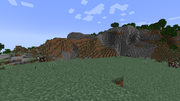 Windswept Hills | |
|
The windswept gravelly hills are mostly covered in gravel with occasional patches of grass and stone blocks. Due to the low amount of grass, the population of spruce and oak trees in this biome is sparse. |
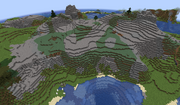 Windswept Gravelly Hills | |
|
This biome is found when the windswept hills are located next to forested biomes. It doesn't generate stone patches so the floor is entirely covered by grass, and there are more spruce and oak trees in this biome, forming small forests with a lower tree density than the taiga biome. |
 Windswept Forest |
Woodland biomes[]
Woodland biomes are rich in plants, with trees, flowers and grasses constituting the flora on the surface. It is one of the ideal birthplaces where plenty of wood resources are available, but the dense vegetation makes it dangerous to move around the forest at night because the trees block the view.
These biomes are further divided into 7 categories: Forests, Taiga, Old Growth Taigas, Snowy Taiga, Birch Forests, Dark Forest, and Jungles.
| Biome name | Description | Screenshot |
|---|---|---|
Forest |
A common biome with many oak and birch trees and a fair amount of tall grass, mushrooms and flowers. This is one of the most preferred biomes to start out in, due to the abundance of wood. Like in taigas, wolves are found. |
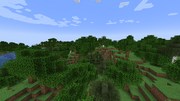 Forest |
Flower Forest |
This forest variant has fewer trees, but more than makes up for it - it is almost overflowing with nearly every type of flower and tall plant in the game, several of which grow only in this biome. Therefore, this biome is optimal for harvesting and farming dyes. Wolves do not spawn in the flower forest, although rabbits spawn occasionally. |
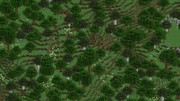 Flower Forest
|
Taiga |
A biome covered by a forest of spruce trees. Ferns, large ferns and berry bushes grow commonly on the forest floor. One can find packs of wolves here, along with small groups of foxes or rabbits. Villages may generate in this biome; the houses in these villages are built of spruce wood. Pillager outposts may also generate in this biome. |
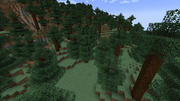 Taiga |
|
The Old Growth Pine Taiga is a biome composed of spruce trees (despite it being called a pine taiga since there is no pine in the game), much like the standard Taiga biome. However, some trees are 2×2 thick and taller than normal, akin to large jungle trees. Mossy cobblestone boulders appear frequently, mushrooms are common, and podzol can be found on the forest floor. There are also patches of coarse dirt that do not grow grass, with some dead bushes. Wolves and foxes may also spawn here, as they do in normal Taiga biomes. Rabbits may also spawn here in Java Edition. |
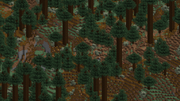 Old Growth Pine Taiga | |
|
At first glance, this biome may look almost exactly the same as its pine tree counterpart. However, the most striking feature of this biome is its giant spruce trees, which are essentially a scaled-up version of regular spruce trees. One can easily differentiate this from an old growth pine taiga by observing how the leaves almost completely cover the tree trunks, whereas in pine ones, leaves tend to cover only the top. |
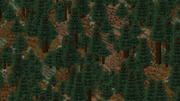 Old Growth Spruce Taiga | |
Snowy Taiga |
Much like the regular Taiga, the Snowy Taiga has large expanses of spruce trees, ferns, and their taller variants, generate here commonly, although grass can still be found. It is one of the few places where wolves and foxes spawn naturally. One may also find an igloo nestled between the trees from a more or less flat terrain, making it one of the three biomes where igloos naturally generate. Villages[BE only] and outposts[BE only] may also generate here. Villages use the same architecture as taiga villages but the villagers wear snowy biome outfits. |
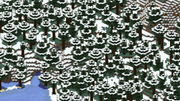 Snowy Taiga
|
Birch Forest |
A forest where the grass is aqua and only birch trees generate. Unlike in the regular Forest, no wolves spawn in this forest. |
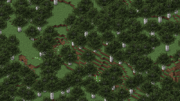 Birch Forest |
|
Birch trees grow much taller than usual in this uncommon variant of the Birch Forest biome. Whereas normal birch trees grow up to 7 blocks tall, these trees usually are 11 blocks in height. This makes deforestation a much more difficult task, although it provides the player with far more resources. |
 Old Growth Birch Forest | |
Dark Forest |
This biome is mainly composed of dark oak trees, a mostly closed roof of leaves, and occasional large mushrooms. Trees in this forest are so packed together, that it's dark enough for hostile mobs to spawn, even during the day. On rare occasions, a woodland mansion may spawn, making the dark forest the only biome in which woodland mansions can be found. |
 Dark Forest |
Jungle |
A dense forested biome. It features ferns and large jungle trees that can reach up to 31 blocks tall with 2×2 thick trunks. Oak trees are also common though. The landscape is lush green, leaves cover much of the forest floor—these "bush trees" have single-blocks of jungle wood for trunks, surrounded by oak or jungle leaves. Vines are found alongside most blocks and may cover the surface of caves. Ocelots, pyramids, melons, cocoa, pandas and parrots exclusively generate in this biome. Melons generate in patches, similar to pumpkins, but are common. |
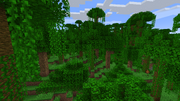 Jungle |
Sparse Jungle |
In stark contrast to the wild and overgrown vegetation of the jungle biomes, the sparse jungle consists of a few small and isolated jungle trees, with patches of melons here and there. The terrain in which this biome can generate is often flat, with some small rises in elevation. All mobs that spawn in the jungle, including parrots, ocelots, and pandas[Bedrock Edition only], also spawn in the sparse jungle. |
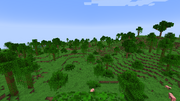 Sparse Jungle |
Bamboo Jungle |
The terrain in this biome is covered by grass with some patches of podzol. Unlike the normal Jungle, bushes still generate but do not cover the floor. Additionally, large jungle trees can generate only here, along with large or balloon oak trees. The density of trees in this biome is much less compared to jungle edge, but massive amounts of bamboo shoots generate covering this biome. Jungle exclusive mobs such as ocelots and parrots can spawn in here, pandas have a higher spawn rate than in regular jungle. Jungle pyramids can also generate.[Java Edition only] |
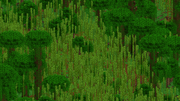 Bamboo Jungle |
Wetland biomes[]
Wetland biomes contains rivers, swamps and beaches. They have a large amount of water resources. Rivers separate other biomes; beaches generate as a transition between the ocean and land.
| Biome name | Description | Screenshot |
|---|---|---|
River |
A biome that consists of water blocks that form an elongated, curving shape similar to a real river. Unlike real rivers, however, they have no current. Rivers cut through terrain or separate the main biomes. They attempt to join up with Ocean biomes, but sometimes loop around to the same area of ocean. Rarely, they can have no connection to an ocean, instead of forming a loop. The grass has a dull aqua tone, much like the ocean, and trace amounts of oak trees tend to generate there as well. Rivers are also a reliable source of clay. These biomes are good for fishing, but drowned can spawn at night. In Bedrock Edition, mobs other than salmon, squid and drowned cannot spawn in this biome, even underground, except in a monster spawner. |
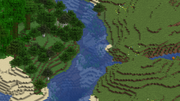 River |
Frozen River |
A river with a layer of ice covering its surface. It generates when a river goes through snowy biomes. Salmon spawn underwater while rabbits and polar bears spawn on ice. At night, Drowned can spawn below the ice with Strays on the surface. In Bedrock Edition, no other hostile mobs can spawn here, even underground, except in a monster spawner. |
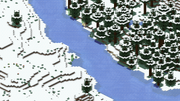 Frozen River |
Swamp |
A biome characterized by a mix of flat areas around sea level and shallow pools of green water with floating lily pads. Clay, sand, and dirt are commonly found at the bottom of these pools. Trees are covered with vines and can be found growing out from the water. Mushrooms and sugar canes are abundant, and blue orchids grow exclusively here. Frogs of the temperate variant can spawn here as well. Swamp Huts with a black cat and a witch generate exclusively in swamps. Slimes also spawn naturally at night, most commonly on full moons. Some zombies may end up underwater, which can transform them into drowned, making this an especially dangerous biome at night. Temperature varies within the biome, causing foliage and grass colors to vary. In Bedrock Edition, huge mushrooms also spawn in this biome. Visibility is also lower than other biomes when the player is underwater. |
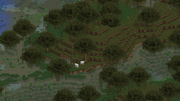 Swamp 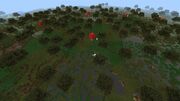 Swamp in Bedrock Edition |
Mangrove Swamp |
A biome characterized by a dense foliage, featuring plenty of mangrove trees which vary a lot in height. The floor is mainly composed of mud blocks with occasional grass patches. The grass has the same color as the normal swamp but leaves and vines have a unique light green tint and the water is teal rather than gray. Frogs often spawn in this biome and all frogs spawned here are warm frogs. Slimes also spawn naturally at night, most commonly on full moons. Just like in the swamp, some zombies may end up underwater, which can transform them into drowned, making this an especially dangerous biome at night, as well as visibility being lower than other biomes when the player is underwater. |
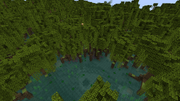 Mangrove Swamp |
Beach |
Generated where oceans meet other biomes, beaches are primarily composed of sand. Beaches penetrate the landscape, removing the original blocks and placing in sand blocks. These are also useful for fishing. Passive mobs other than turtles do not spawn on beaches. |
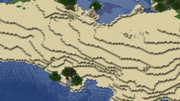 Beach |
Snowy Beach |
Like a regular beach, one can find plenty of sand in this biome and buried treasure can be found underground in this snowy beach. However, sand is covered in a layer of snow. Snowy beaches are found when a snowy biome borders a frozen ocean biome. No passive mobs other than rabbits [Bedrock Edition only] spawn in this biome. |
 Snowy Beach |
|
True to its name, this stone-covered biome often appears where mountains meet the ocean. Depending on the height of the nearby land, Stony Shores may generate as medium slopes or huge cliffs, its tops tall enough to be covered by snow even when near warmer biomes.[1] No passive mobs spawn here. Buried treasure can generate here[BE only]. Strips of gravel can sometimes be found here. |
 Stony Shore |
Flatland biomes[]
These biomes have a flat terrain and a wide view. Trees spawn less here, while lakes are more common here.
These biomes are further divided into two categories: Plains and Snowy Plains.
| Biome name | Description | Screenshot |
|---|---|---|
Plains |
A flat and grassy biome with rolling hills and few oak trees. Villages are common. Cave openings, lava lakes and waterfalls are easily identifiable due to the flat unobstructed terrain. Farm mobs are easily found in Plains biomes; this biome and its variants are also of the few biomes where horses spawn naturally. Pillager outposts may also be generated. |
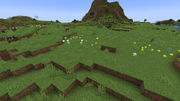 Plains |
Sunflower Plains |
A fairly uncommon variation of the plains, this biome is the only place where sunflowers naturally generate, hence the name. They grow in abundance, making yellow dye a widely available resource. |
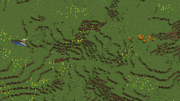 Sunflower Plains |
Snowy Plains |
An expansive biome with a huge amount of snow layers. Sugar cane can generate in this biome, but can become uprooted when chunks load as the water sources freeze to ice. There are few spruce trees in this biome. No animal mobs other than rabbits and polar bears are able to spawn, however, it is one of the few biomes where strays appear, a hostile mob similar to skeletons, except they shoot arrows of slowness. In Bedrock Edition, this biome doesn't spawn monsters other than strays and skeletons, but monster spawners can still spawn monsters. Due to the biome's size and scarcity of wood and animals, initial survival becomes difficult in comparison to other biomes. This is one of the three biomes where igloos naturally generate. Villages and pillager outposts may also generate here. |
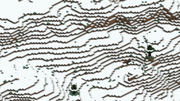 Snowy Plains |
Ice Spikes |
A rare variation of the Snowy Plains biome that features large spikes and glaciers of packed ice. Usually, the spikes are 10 to 20 blocks tall, but some long, thin spikes can reach over 50 blocks in height. The floor in this biome is entirely covered in snow blocks instead of grass, and ice patchs made of packed ice can generate on it. Like the regular snowy plains, no animal mobs other than rabbits and polar bears are able to spawn and strays appear at night. |
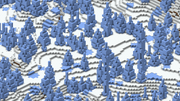 Ice Spikes |
Arid-land biomes[]
In these biomes, it neither rains nor snows at all, but the sky still turns overcast during inclement weather. The surface is covered with sparse vegetation.
These biomes are further divided into three categories: Deserts, Savannas, and Badlands.
| Biome name | Description | Screenshot |
|---|---|---|
Desert |
A barren and inhospitable biome consisting mostly of sand dunes, dead bushes, and cacti. Sandstone, and sometimes fossils, are found underneath the sand. The only passive mobs that spawn naturally in deserts are gold/creamy rabbits, their coloring well-camouflaged against the sand. At night, husks usually spawn in the place of normal zombies; the lack of visual obstruction makes hostile mobs highly visible. Sugar cane can be found if the desert is next to a river biome. Desert villages, desert wells, and desert pyramids are found exclusively in this biome. Pillager outposts can also generate here. |
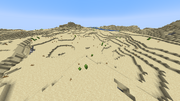 Desert |
Savanna |
A relatively flat and dry biome with a dull-brown grass color and acacia trees scattered around the biome, though oak trees may generate now and then. Tall grass covers the landscape. Villages can generate in this biome, constructed of acacia wood, with some colored terracotta. Pillager outposts can also generate here. Armadillos, horses and llamas[BE only] can naturally spawn here. |
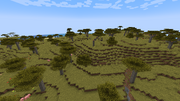 Savanna |
Savanna Plateau |
Savanna plateau biomes generate when a savanna biome generates at high altitudes and near mountains. It is mostly indistinguishable from the standard savanna with the main differences being the fact that llamas can spawn and villages and pillager outposts can't generate. |
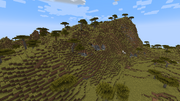 Savanna Plateau |
|
Unlike the mostly flat and calm terrain of the savanna biome, this uncommon variant generates in chaotic terrain covered in gigantic mountains covered in coarse dirt and some patch of stone. The mountains in the windswept savanna biome are extremely steep, jutting out at 90-degree angles, making it almost impossible to climb. Ocean-like lakes also generate here. On top of that, they can reach heights comparable to the mountain peak biomes - they can rise above the clouds. Massive waterfalls and lavafalls are quite common here. The unforgiving terrain means villages and outposts do not generate in this biome. Surprisingly, llamas can naturally spawn here[Bedrock Edition only]. |
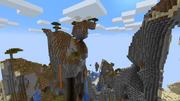 Windswept Savanna | |
Badlands |
An uncommon biome where large mounds of terracotta and stained terracotta generate. Red sand also generates here instead of regular sand, with occasional cacti and dead bushes. This biome is usually found alongside desert biomes and it can generate in mountainous terrain. The only passive mobs which spawn in this biome are armadillos. Mineshafts generate at a higher altitude than normal - occasionally a player may come across a mineshaft jutting out of the Badlands. Gold ore also occurs more frequently, because additional blobs can generate within badlands up to y=256. The composition of this biome is useful when other sources of terracotta and gold are scarce.
|
 Badlands |
|
The wooded badlands has layers of coarse dirt and forests of oak trees that generate atop the badlands in humid areas. The color of the grass and leaves is a dull green-brown hue, giving it a dried and dead appearance. These trees are a rare source of wood when living in the otherwise barren and lifeless badlands. |
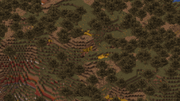 Wooded Badlands | |
Eroded Badlands |
This rare variant generates unique terrain features that are similar to the structures in Utah's Bryce Canyon. Tall and narrow spires of colorful terracotta rise out of the floor of the canyon, which like all other badlands variants, is covered in red sand. |
 Eroded Badlands |
Cave biomes[]
These biomes generates inside caves in the Overworld. They're mostly found underground but can sometimes leak out of cave entrances.
| Biome name | Description | Screenshot |
|---|---|---|
Deep Dark |
A dimly lit cave biome that generates deep underground mostly within the deepslate layer. It is largely sculk blocks 1 block thick upon all surfaces, with frequent sculk sensors and occasional sculk shriekers of which the latter can directly summon the warden (or multiple wardens). An ancient city is a large structure which can generate here, including a warden-like city Center generated structure (and valuable chests with unique loot, including a high chance of finding enchanted golden apples, which are widely considered to be the rarest item in the game). As with mushroom fields, no other hostile mobs spawn here. While breaking sculk blocks, which can even be generated via mobs dying near a sculk catalyst, can be a good source of experience, the very high chance of instant death from a nearly unkillable warden (with a ranged attack) means that this is the most dangerous place in the Overworld to attempt this method for leveling-up. |
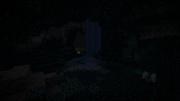 Deep Dark |
Dripstone Caves |
These are caves filled with dripstone blocks and pointed dripstone both hanging as stalactites and growing from the ground as stalagmites and small water wells of 1 × 1 in the ground. Large dripstone cluster structures generate occasionally inside these caves. Copper ore blobs found in this biome are much bigger compared to other biomes. Drowned are able to spawn in aquifers. |
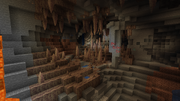 Dripstone Caves |
Lush Caves |
Lush caves are often found underground below azalea trees. As the name suggests, these caves are lush and covered by moss, moss carpets, grass and azalea bushes on the floors. On the ceiling, vines and cave vines with glow berries grow down and light up the caves, and spore blossoms grow from the ceiling and spore particles. There are also shallow lakes with clay where dripleaf plants grow out of them and axolotls spawn, making this the only biome where they can spawn. Tropical fish can also spawn inside the aquifers in a lush cave. Azalea trees spawn above ground when there are lush caves underneath. |
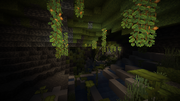 Lush Caves |
Void biomes[]
| Biome name | Description | Screenshot |
|---|---|---|
The Void[Java Edition only] |
Can be accessed only through Buffet world selection or The Void superflat preset. In a Buffet world, the landscape consists of stone, as well as water and bedrock depending on the generator type. In The Void superflat preset, the world is empty except for a single structure: a 33×33 stone platform with a single block of cobblestone in the center. No mobs (passive or hostile) can spawn without spawn eggs, monster spawners, or commands. It doesn't rain in this biome. |
 The Void |
The Nether[]
The Nether is considered a different dimension. It is a hellish place; all biomes in this dimension are dry and it is not possible to place water in these biomes; ice can still be placed, though it does not turn into water upon melting.
| Biome name | Description | Screenshot |
|---|---|---|
Nether Wastes |
The nether wastes is a massive cave that carves through the majority of the dimension. The main terrain consists of netherrack, with glowstone clusters growing and lava leaking from the ceiling and gravel and soul sand lining its shores. It is the most barren Nether biome, but also the easiest to traverse as there is largely no terrain that could possibly block your path. The only real threats would be the monsters, the fire-breathing ghasts, the piglins and their undead versions, the powerful magma cubes, and the rare enderman. |
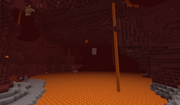 Nether Wastes |
Soul Sand Valley |
The soul sand valley is a large grotto that is extensive and cuts through the Nether's usual terrain. Notable features of the biome are exposed nether fossils in various shapes and sizes, large amounts of lava, blue fog, large spires made of basalt, soul fire, and the occasional nether fortress or Bastion remnant. The biome itself consists of soul sand, basalt and soul soil. This biome is extremely dangerous to traverse due to the combination of Ghasts and Skeletons spawning here and soul sand slowing down the player's movement speed, making it easy for a player to get overwhelmed by projectile attacks. In addition, igniting soul sand or soul soil (especially since Ghast fireballs start fires near impact point) can create soul fire, which does more damage/second than regular fire if players get caught in it. It is recommended to avoid this biome unless players have sufficient equipment/strategies to navigate the terrain. The Soul Speed enchantment is especially helpful for traveling through this biome. |
 Soul Sand Valley |
Crimson Forest |
The Crimson Forest is a “red” crimson-themed biome, with warped and crimson fungus as well as huge crimson fungus scattered around the environment. There are huge fungus structures that contain weeping vines hanging off them and may also have a few blocks of shroomlight. The floor of the biome is covered in crimson nylium, with crimson roots growing. Occasional patches of netherrack and red nether wart blocks are found scattered throughout the biome. In the ceiling, apart from glowstone clusters, there are sparse nether wart block stalactites with vines growing. Piglins, zombified piglins and hoglins naturally spawn in this biome. As long as players equip at least one piece of gold armor, piglins should not cause any trouble. Hoglins can also be repelled by staying close to warped fungus. However, without these countermeasures, this biome can be fairly hostile to navigate. Nevertheless, the abundance of hoglins in this biome makes it a great source of food in the Nether, and the high population of piglins makes this biome an ideal location to barter with them. |
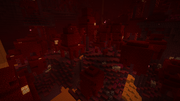 Crimson Forest |
Warped Forest |
The huge fungus structures may have a few blocks of shroomlight scattered around them. The floor of the biome is covered in warped nylium, with warped roots and nether sprouts growing. Occasional patches of raw netherrack and warped wart blocks can be found scattered throughout the biome. Apart from striders, endermen are the only mobs that spawn in this biome, making the warped forest an ideal location to collect ender pearls to access the End. This biome is also a relatively safe place to reside in the Nether, due to the fact that no hostile mobs spawn here. However, do note that other hostile mobs can still spawn from bastion remnants that generate here, as well as from nether fortresses that have cut into a warped forest after generating in another biome. |
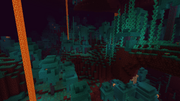 Warped Forest |
Basalt Deltas |
A gray biome, the basalt deltas are said to be the remnant of ancient volcanic eruptions. The ground consists of basalt and blackstone blocks, with small patches of netherrack and pools of lava. The shape of the terrain is chaotic and uneven, making it somewhat difficult to traverse and build on. Unlike the other biomes in the Nether, bastion remnants do not generate in basalt deltas. When this biome borders a lava ocean, clusters of basalt form near the coast. Magma cubes have a high spawn rate in this biome, making the basalt deltas the best place to farm magma cream. This biome also contains a much higher abundance of blackstone compared to other Nether biomes. |
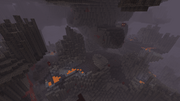 Basalt Deltas |
The End[]
The End is considered a different dimension.
| Biome name | Description | Screenshot |
|---|---|---|
The End |
This biome is used to generate the circle of radius 1000 centered at the 0,0 coordinates in the End. The End central island is generated at the center of this circle, and it's surrounded by a complete vacuum all the way to the edge of the biome. Most of the End features are exclusive to that island, including the ender dragon, the obsidian pillars, the end crystals, the 5x5 spawn platform, the exit portal and the 20 central end gateways. Large amounts of endermen spawn in this biome. It does not rain or snow in this biome unlike the other low-temperature biomes. The outer islands in the End can be accessed using end gateways after the ender dragon has been defeated. If the biome is used for a superflat world, the sky appears nearly black and an ender dragon spawns at the 0,0 coordinates in the Overworld. Only endermen spawn at night. |
 The End |
Small End Islands |
Generates as part of the outer islands of the End. This biome represents the empty expanse between the larger islands, populated by the smaller, circular islands. |
 Small End Islands |
End Midlands |
Generates as part of the outer islands of the End. This biome represents the gradual slope from the hilltops of each island down to the cliffs around the edge. End cities generate here, but chorus trees do not. |
 End Midlands |
End Highlands |
Generates as part of the outer islands of the End. This biome represents the hilltops of each island, and is the only biome in the End where both chorus trees and end cities generate. |
 End Highlands |
End Barrens |
Generates as part of the outer islands of the End. This biome represents the outer rims of each island, with steep cliffs below the edge. Neither end cities nor chorus trees generate in this biome. |
 End Barrens |
Unused biomes[]
These biomes don't generate in default worlds. They have been completely removed from the game in Java Edition.
| Biome name | Features | Description | Screenshot | |
|---|---|---|---|---|
Legacy Frozen Ocean |
Polar Bears, Salmon, Cod, Strays, Cold underwater ruins, Gravel, Seagrass, kelp, Snowy Rabbits, Ice, shipwrecks |
Similar to the Frozen Ocean biome, but without icebergs, it is completely flat. Because they are a Frozen Ocean variant, they can spawn polar bears and strays, but not dolphins. Unlike the regular frozen ocean, polar bears, drowned, squid, salmon, cod, rabbits, skeletons, and strays are the only mobs that spawn here. Kelp also generates here. This biome doesn't generate naturally from Pocket Edition Alpha 0.9.0 onward. When Bedrock Edition 1.4.0 introduced the new frozen ocean, this biome was not removed or replaced by the new frozen ocean, although the id name changed from frozen_ocean to legacy_frozen_ocean.
|
 Legacy Frozen Ocean | |
Desert Lakes |
Sand, Cacti, Water, Sugar Canes, Gold Rabbits, Desert well, Fossils, Husk |
In this biome, patches of water are more common, and the terrain is slightly more rough. Although desert wells can be found, desert pyramids, villages, and outposts do not generate in this biome. |  Desert Lakes | |
Mountain Edge |
Grass, Dirt, Stone, Llamas, Emerald ore, Infested stone, Spruce trees, Oak trees, Snow |
Similar to the sparse jungle biome, the mountain edge used to generate exclusively at the edge of windswept hills biomes in order to smooth the transition between biomes. This biome has lots of trees, similar to windswept forests. While the terrain is lower and gentler in nature, some areas may reach high enough to be covered by snow. This biome doesn't generate naturally from Pocket Edition v0.9.0 alpha and Java Edition 1.7.2 onward. |  Mountain Edge | |
Deep Warm Ocean |
Dolphins, Pufferfish, Tropical fishes, Warm underwater ruins, Sand, Seagrass, Ocean monuments, Guardians, Elder guardians, shipwrecks |
Similar to the Warm Ocean biome, but without coral reefs or sea pickles, and twice as deep. Because they are a deep ocean variant, they can generate ocean monuments, resulting in the spawning of guardians, elder guardians, prismarine, and sponges. | 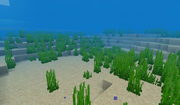 Deep Warm Ocean | |
| Hills |
Hills are generated within certain biomes (including some of their variants) and are referred in the F3 menu with Hills added to their name (except Snowy Mountains).
This includes: Wooded Hills, Taiga Hills, Snowy Taiga Hills, Jungle Hills, Desert Hills, Birch Forest Hills, Tall Birch Hills, Giant Tree Taiga Hills, Giant Spruce Taiga Hills, Snowy Mountains, and Bamboo Jungle Hills. Most hills are gentle rolling slopes on which the usual biome terrain generates, with some sharper cliffs here and there. Snowy Mountains have a lower chance of spawning passive mobs during world generation than other biomes (7% versus 10%). Giant Spruce Taiga Hills are a special case. In Java Edition, the game code sets the values |
 Giant Tree Taiga Hills  Desert Hills  Jungle Hills  Snowy Mountains | ||
Badlands Plateau |
Badlands plateaus generate as actual biomes within Badlands biomes, and are flattened at the top, much like real-life plateaus. They come to rest at an elevation of about 20 to 30 blocks above sea level. One may discover the entrance to a mineshaft within the tall slopes of a Badlands Plateau. |
 Badlands Plateau | ||
| Modified Plateaus |
Two rare variants of the plateau biomes, which are variants themselves. However, neither of these biomes closely resemble their counterparts.
Compared to the average Badlands Plateau, the Modified Badlands Plateau features more variable terrain and smaller plateaus, as if a larger plateau was weathered down over time. It is the second-rarest biome in the game, after the Modified Jungle Edge. The terrain of the Shattered Savanna Plateau biome is much less tame than its normal counterpart. It features incredibly large and steep mountains that jut out of the terrain, similar to the Shattered Savanna biome, albeit slightly smaller and gentler in comparison. In Bedrock Edition, shattered savanna plateaus are considered a temperate/lush biome, making foliage a vibrant green color and allowing rain to occur in them.[2] |
 Modified Badlands Plateau  Shattered Savanna Plateau |
||
Modified Wooded Badlands Plateau |
This biome features grass and oak trees on top of plateaus, much like its counterpart. However, the plateaus that generate here are generally smaller, allowing far less foliage to generate. The terrain is more erratic, and can be compared to that of the similar Modified Badlands Plateau biome, having an old and eroded appearance. Eroded badlands generate instead of desert alongside this biome. |
 Modified Wooded Badlands Plateau | ||
Mushroom Field Shore |
Mushrooms, Huge Mushrooms, Mycelium, Mooshrooms, Buried Treasure, Shipwreck |
Mushroom Field Shores represent the transition between mushroom fields and the ocean, forming long strips between the biomes as a "beach", hence the name. However, it does not generate if the ocean biome is a Deep Ocean. This biome also generates when a river meets a Mushroom Fields biome, similar to what Frozen Rivers do in Snowy Plains. The terrain of this biome is much more flat and shallow than the main Mushroom Fields biome, though it contains many of the same features, such as a mycelium surface layer, huge mushrooms, and lack of hostile mobs, but shipwrecks and buried treasure can generate here. |  Mushroom Field Shore |
Removed biomes[]
These biomes no longer exist in current versions of the game.
| Biome name | Features | Description | Screenshot |
|---|---|---|---|
Tundra |
Snowy, barren terrain with few trees. The occasional trees do exist, although rarely. Ice can be found over water. Snow is common weather in tundras. It generates when the temperature is below 50% and the downfall is less than 20%. |
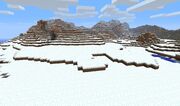 Tundra | |
Rain Forest |
Rainforests are wet biomes with many trees, which have a 1 in 3 chance of being big, instead of 1 in 10 like all other biomes. They generate only oak trees and have a large amount of tall grass and ferns. A biome is classified as a rainforest if the temperature is greater than 97% and the downfall is more than 90%. This could be the biome with some of the most cliffs and hills because the world generator reduces height variation at lower downfalls. |
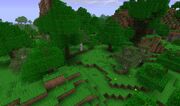 Rainforest | |
Seasonal Forest |
Seasonal Forests spawn with a temperature of 97% or greater, and a downfall value between 45% and 90%. They are commonly found between forest and rain forests, and near plains biomes. They are identical to forests, except they have fewer trees and can spawn only oak trees. They have a little bit of tall grass. | 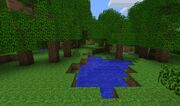 Seasonal Forest | |
Ice Desert |
An unused biome before Beta 1.8 that was in the code but never implemented into the temperature/downfall table and thus did not actually generate. It was a biome of sand with snow on top of it and had snowfall and ice (the player can create something similar using the buffet world option and choosing the snowy beach biome). |
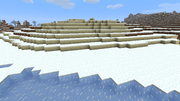 Ice Desert Biome | |
Shrubland |
A biome with few trees and no tall grass. It is identical to the savanna biome. It is one of the smallest biomes in the game. It can generate if the temperature is between 50% and 97%, and the downfall value is below 35%. It is too small to generate a forest. | 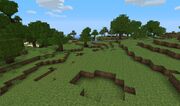 Shrubland |
Joke biomes[]
These biomes can only appear in joke snapshots of the game.
| Biome name | Features | Description | Screenshot |
|---|---|---|---|
_generated:id
|
|||
Between |
End Ships | Grid of End Ships. Generates in the fleet dimension. There is no elytra as loot. Chests generate, but contain only a book titled "orders" | 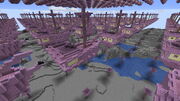 A between biome generated in a buffet world. |
Biome For Player With No Time For Nonsense |
Generates as Snowy Taiga, but all ores are mineral blocks or redstone components |  Biome For Player With No Time For Nonsense, generated in the busy dimension. You can see a redstone block in the mountain. | |
The Moon |
Moon Cow, Lunar Base, Cheese | Generates flat terrain with craters. The only mob that spawns here is the moon cow. There is also the Lunar Base, the only feature in the moon. | 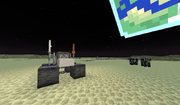 The moon |
Shapes |
Terracotta, Glazed Terracotta, Concrete, Concrete Powder, Wool, Carpet, Stained Glass, Stained Glass Pane | Generates Spheres, Cubes, Ocathedra, etc. of various colors and materials | 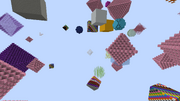 Shapes biome |
Tint[]
Plants[]
Biome grass and foliage colors are selected from two 256×256 colormap images: grass.png and foliage.png under assets/minecraft/textures/colormap[JE only] or textures/colormap[BE only]. The grass.png colormap sets the colors for grass block, ferns in flower pots, grass, tall grass, sugar canes, stems of pink petals. Meanwhile, the foliage.png colormap sets the colors for vines and tree leaves of oak, jungle, acacia, dark oak, and mangrove. Only the colors in the lower-left halfs of both images are used, even though the upper-right side of foliage.png is colored.
The adjusted temperature and adjusted downfall values (recognized as AdjTemp and AdjDownfall in the following, respectively) are used when determining the biome color to select from the colormap. They are computed as follows:
AdjTemp = clamp( Temperature, 0.0, 1.0 )
AdjDownfall = clamp( Downfall, 0.0, 1.0 ) * AdjTemp.
"clamp" limits the range of the temperature and downfall to 0.0—1.0. The clamped downfall value is then multiplied by the adjusted temperature value, bringing its value to be inside the lower left triangle. Treating the bottom-right corner of the colormap as AdjTemp = 0.0 and AdjDownfall = 0.0, the adjusted temperature increases to 1.0 along the X-axis, and the adjusted downfall increases to 1.0 along the Y-axis.
Special plant tints[]
In the following cases, the plants are not tinted exactly according to the colormap. In Java Edition, severals of them are specified in biome Jsons in vanilla data pack.
- Swamps
In Swamp and Mangrove Swamp, the color for grass blocks, ferns in flower pots, grass, sugar canes, and the stems of pink petals is based on a noise on XZ plane. When the value of this noise is less than -0.1, it uses the color
#4c763c. Otherwise using
#6a7039. The color for vines and leaves of oaks, jungles, acacias, dark oaks and mangroves is
#6a7039 in Swamp and
#8db127 in Mangrove Swamp, which are not affected by the colormap.
- Dark Forest
In Dark Forest, the color for grass blocks, ferns in flower pots, grass, sugar canes, and the stems of pink petals is the result of the bitwise AND between the color in the colormap and
#fefefe, and then averaging with
#28340a. In vanilla, that is
#507a32.
- Badlands
In Badland, Wooded Badland, and Erosion Badland, the color for grass blocks, ferns in flower pots, grass, sugar canes, and the stems of pink petals is
#90814d. The color for vines and leaves of oaks, jungles, acacias, dark oaks and mangroves is
#9e814d. Both are not affected by the colormap.
- Cherry Grove
The color for plants in the Cherry Grove is always
#b6db61, which is not affected by the colormap.
- Other leaves
The color for spruce leaves is
#619961 and the color for birch leaves is
#80a755. Both are not affected by the biome.
Environment[]
The color of the sky in Overworld changes according to the basic temperature value of the biome. The basic temperature is first modified as T = clamp( Temperature / 3 , -1.0, 1.0 ). Then the triple is the sky color.
In addition, the colors of water, underwater fog and fog in a biome are defined in the vanilla data pack[JE only] or vanilla resource packs[BE only].
See the List of biome climates for these colors.
Transition[]
When plants or water are at the borders between or among biomes, the color is affected by the biome of the surrounding blocks at the same Y-level. The range of the block involved in the calculation is determined by the biome blend radius in options. Takes the plant color or water color of the biomes within a square centered on this block and with the side length being the biome blend radius, and calculates their average value to get the final color for this block.
The sky color [JE only] and the fog color use the color processed by Gaussian blur from colors of the biomes at each block in the range of 5×5×5 centered on the block the camera is in.
Climate[]
A biome has three climate attributes: temperature, downfall, and precipitation.
Temperature[]
Each biome has a base temperature value (see the List of biome climates), but the actual temperature value at each location in the biome is also affected by the height of the location. Locations with Y≤80 use the base temperature as actual temperature. At Y=81, the actual temperature value randomly fluctuates up and down by -0.00875 — +0.01125 from the base temperature based on a noise on the XZ plane, and at Y≥81 the actual temperature decreases by 0.00125 (1⁄800) every block up.
In Java Edition, specially, in Frozen Ocean and Deep Frozen Ocean, it is also affected by another noise on XZ plane. In some regions according to the noise, the base temperature value is always regarded as 0.2. The actual temperature values for these regions are also calculated on this basis. This is detectable in Frozen Ocean, as its base temperature is low enough to freeze or snow, so that only these regions do not freeze or snow at sea level.
Downfall[]
The downfall value is a number between 0.0 and 1.0 (see the List of biome climates). When the downfall value is greater than 0.85, the biome is marked as humid, which is related only to the random extinction of fire. This value doesn't affect the weather.
Precipitation[]
The precipitation value can be "true" or "false". If the precipitation of the biome is false, no rain or snow occur. Otherwise, a location is rainable when its temperature value is greater than 0.15, and snowable otherwise.
So, if the base temperature is not greater than 0.15, it's snowable at any Y level. And if greater than 0.15, it can snow above a certain Y level, which are listed below:
| Biomes | Minimum height for snowfall |
|---|---|
| Windswept Hills Windswept Gravelly Hills Windswept Forest Stony Shore[1] Dripstone Caves[BE only][3] Some regions of Frozen Ocean and Deep Frozen Ocean |
120±8 |
| Old Growth Spruce Taiga Taiga |
160±8 |
| Old Growth Pine Taiga Meadow[BE only] Cherry Grove[BE only] |
200±8 |
| Others | Out of world |
Snow accumulation[]
In Java Edition, the maximum snow accumulation layer can be set by snowAccumulationHeight game rules. In Bedrock Edition, the maximun snow layer is based on the snow accumulation value of the biome. The value is a array of 2 numbers, representing the minimum and maximum snow heights, with 0.0 being no snow and 1.0 being the full height of one block.
List of biome climates[]
Overworld[]
| Biomes | Base temperature | Downfall | Precipitation | Snow Accumulation[BE only] | Grass color | Leaf color | Sky color | Fog color |
|---|---|---|---|---|---|---|---|---|
| The Void[JE only] | 0.5 | 0.5 | FALSE | N/A | #8eb971 |
#71a74d |
#7ba4ff |
#c0d8ff[JE only] #abd2ff[BE only] |
| Warm Ocean | TRUE | 0.0-0.125 | ||||||
| Lukewarm Ocean | ||||||||
| Deep Lukewarm Ocean | ||||||||
| Ocean | ||||||||
| Deep Ocean | ||||||||
| Cold Ocean | ||||||||
| Deep Cold Ocean | ||||||||
| River | ||||||||
| Deep Frozen Ocean | 0.5[JE only] | 0.5 | 0.125-0.25 | #8eb971[JE only] |
#71a74d[JE only] |
#7ba4ff[JE only] | ||
| 0.0[BE only] | #80b497[BE only] |
#60a17b[BE only] |
#7fa1ff[BE only] | |||||
| Lush Caves | 0.5[JE only] | 0.5[JE only] | 0.0-0.125 | #8eb971[JE only] |
#71a74d[JE only] |
#7ba4ff[JE only] | ||
| 0.9[BE only] | 0.0[BE only] | #b9b75b[BE only] |
#a6a432[BE only] |
#77a8ff[BE only] | ||||
| Plains | 0.8 | 0.4 | #91bd59 |
#77ab2f |
#78a7ff | |||
| Beach | ||||||||
| Sunflower Plains | ||||||||
| Deep Dark | ||||||||
| Dripstone Caves | 0.8[JE only] | 0.4[JE only] | #91bd59[JE only] |
#77ab2f[JE only] |
#78a7ff[JE only] | |||
| 0.2[BE only] | 0.0[BE only] | #8db58a[BE only] |
#70a26c[BE only] |
#7da2ff[BE only] | ||||
| Frozen River | 0.0 | 0.5 | 0.125-0.25 | #80b497 |
#60a17b |
#7fa1ff | ||
| Frozen Ocean | ||||||||
| Snowy Plains | 0.25-1.0 | |||||||
| Ice Spikes | 0.5[JE only] | 0.5-1.5 | ||||||
| 1.0[BE only] | ||||||||
| Grove | -0.2 | 0.8 | 0.125-0.25 | #81a0ff | ||||
| Frozen Peaks | -0.7 | 0.9 | #859dff | |||||
| Jagged Peaks | ||||||||
| Snowy Slopes | -0.3 | 0.9 | 0.125-0.5 | #829fff | ||||
| Snowy Taiga | -0.5 | 0.4 | #839eff | |||||
| Snowy Beach | 0.05 | 0.3 | 0.125-0.25 | #83b593 |
#64a278 |
#7fa1ff | ||
| Meadow | 0.5[JE only] | 0.8 | 0.0-0.125 | #83bb6d[JE only] |
#63a948[JE only] |
#7ba4ff[JE only] | ||
| 0.3[BE only] | #86b87f[BE only] |
#68a55f[BE only] |
#7ca3ff[BE only] | |||||
| Cherry Grove | 0.5[JE only] | #b6db61 |
#b6db61 |
#7ba4ff[JE only] | ||||
| 0.3[BE only] | #7ca3ff[BE only] | |||||||
| Desert | 2.0 | 0.0 | FALSE | #bfb755 |
#aea42a |
#6eb1ff | ||
| Savanna | 2.0[JE only] | #6eb1ff[JE only] | ||||||
| Savanna Plateau | ||||||||
| Savanna | 1.2[BE only] | #75aaff[BE only] | ||||||
| Savanna Plateau | 1.0[BE only] | #76a8ff[BE only] | ||||||
| Windswept Savanna | 2.0 | 0.0 | #bfb755 |
#aea42a |
#6eb1ff[JE only] | |||
#76a9ff[BE only] | ||||||||
| Badlands | 2.0 | 0.0 | #90814d |
#9e814d |
#6eb1ff | |||
| Wooded Badlands | ||||||||
| Eroded Badlands | ||||||||
| Forest | 0.7 | 0.8 | TRUE | #79c05a |
#59ae30 |
#79a6ff | ||
| Flower Forest | ||||||||
| Dark Forest | #507a32 | |||||||
| Birch Forest | 0.6 | 0.6 | #88bb67 |
#6ba941 |
#7aa5ff | |||
| Old Growth Birch Forest | ||||||||
| Old Growth Pine Taiga | 0.3 | 0.8 | #86b87f |
#68a55f |
#7ca3ff | |||
| Old Growth Spruce Taiga | 0.25 | 0.8 | #86b783 |
#68a464 |
#7da3ff | |||
| Taiga | ||||||||
| Windswept Gravelly Hills | 0.2 | 0.3 | #8ab689 |
#6da36b |
#7da2ff | |||
| Windswept Forest | ||||||||
| Windswept Hills | 0.0-0.25 | |||||||
| Stony Shore | ||||||||
| Jungle | 0.95 | 0.9 | 0.0-0.125 | #59c93c |
#30bb0b |
#77a8ff | ||
| Bamboo Jungle | ||||||||
| Sparse Jungle | 0.8 | #64c73f |
#3eb80f | |||||
| Mushroom Fields | 0.9 | 1.0 | #55c93f |
#2bbb0f | ||||
| Stony Peaks | 1.0 | 0.3 | #9abe4b |
#82ac1e |
#76a8ff | |||
| Mangrove Swamp | 0.8 | 0.9 | #6a7039 #4c763c |
#6a7039 |
#78a7ff | |||
| Swamp | 0.9[JE only] | #8db127 | ||||||
| 0.5[BE only] |
| Biome | Water color in Bedrock Edition | Water fog color in Bedrock Edition | Water color in Java Edition | Water fog color in Java Edition |
|---|---|---|---|---|
| Swamp | #617b64 |
#232317 |
#4c6559 |
#4c6559 |
| Mangrove Swamp | #3a7a6a |
#4d7a60 |
#3a7a6a |
#4d7a60 |
| Warm Ocean | #02b0e5 |
#0289d5 |
#43d5ee |
#041f33 |
| Lukewarm Ocean | #0d96db |
#0a74c4 |
#45adf2 |
#041633 |
| Deep Lukewarm Ocean | #0e72b9 | |||
| Cold Ocean | #2080c9 |
#14559b |
#3d57d6 |
#050533 |
| Deep Cold Ocean | #185390 | |||
| Snowy Beach | #1463a5 |
#1463a5 | ||
| Snowy Taiga | #205e83 |
#205e83 | ||
| Frozen Ocean | #2570b5 |
#174985 |
#3938c9 | |
| Deep Frozen Ocean | #1a4879 | |||
| Frozen River | #185390 |
#185390 | ||
| Meadow | #44aff5 |
#44aff5 |
#0e4ecf | |
| Cherry Grove | #5db7ef |
#5db7ef |
#5db7ef | |
| Ocean | #1787d4 |
#1165b0 |
#3f76e4 | |
| Deep Ocean | #1463a5 | |||
| River | #0084ff |
#0084ff | ||
| Beach | #157cab |
#157cab | ||
| Stony Shore | #0d67bb |
#0d67bb | ||
| Snowy Plains Ice Spikes |
#14559b |
#14559b | ||
| Taiga | #287082 |
#287082 | ||
| Old Growth Pine Taiga Old Growth Spruce Taiga |
#2d6d77 |
#2d6d77 | ||
| Dark Forest | #3b6cd1 |
#3b6cd1 | ||
| Flower Forest | #20a3cc |
#20a3cc | ||
| Forest | #1e97f2 |
#1e97f2 | ||
| Birch Forest | #0677ce |
#0677ce | ||
| Old Growth Birch Forest | #0a74c4 |
#0a74c4 | ||
| Bamboo Jungle Jungle |
#14a2c5 |
#14a2c5 | ||
| Sparse Jungle | #0d8ae3 |
#0d8ae3 | ||
| Savanna | #2c8b9c |
#2c8b9c | ||
| Windswept Savanna Savanna Plateau |
#2590a8 |
#2590a8 | ||
| Desert | #32a598 |
#32a598 | ||
| Badlands | #4e7f81 |
#4e7f81 | ||
| Eroded Badlands | #497f99 |
#497f99 | ||
| Mushroom Fields | #8a8997 |
#8a8997 | ||
| Wooded Badlands | #55809e |
#55809e | ||
| Windswept Forest Windswept Gravelly Hills |
#0e63ab |
#0e63ab | ||
| Windswept Hills | #007bf7 |
#007bf7 | ||
| Dripstone Caves Deep Dark Lush Caves Frozen Peaks Jagged Peaks Stony Peaks Plains Sunflower Plains Grove Snowy Slopes |
#44aff5 |
#44aff5 | ||
| The Void[JE only] | N/A | N/A |
The Nether[]
| Biome | Base temperature | Downfall | Precipitation | Grass color | Leaf color | Sky color | Water color | Water fog color | Fog color |
|---|---|---|---|---|---|---|---|---|---|
| Nether Wastes | 2.0 | 0.0 | FALSE | #bfb755 |
#aea42a |
#6eb1ff |
#3f76e4[JE only] #905957[BE only] |
#050533[JE only] #905957[BE only] |
#330808 |
| Warped Forest | #1a051a | ||||||||
| Crimson Forest | #330303 | ||||||||
| Soul Sand Valley | #1b4745 | ||||||||
| Basalt Deltas | #3f76e4 |
#050533[JE only] #423e42[BE only] |
#685f70 |
The End[]
| Biome | Base temperature | Downfall | Precipitation | Grass color | Leaf color | Sky color | Water color | Water fog color | Fog color |
|---|---|---|---|---|---|---|---|---|---|
| The End End Highlands[JE only] End Midlands[JE only] Small End Islands[JE only] End Barrens[JE only] |
0.5 | 0.5 | FALSE | #8eb971 |
#71a74d |
#000000 |
#3f76e4[JE only] #62529e[BE only] |
#050533[JE only] #62529e[BE only] |
#a080a0[JE only] #0b080c[BE only] |
Generation[]
Overworld[]
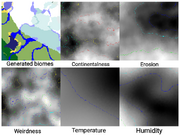
Biomes and density functions
Overworld biome generation is based on 6 parameters: Temperature, Humidity (aka. Vegetation), Continentalness (aka. Continents), Erosion, Weirdness (aka. Ridges) and Depth, which are calculated with 6 density functions. They respectively correspond to T, V, C, E, W and D in the "NoiseRouter" line of debug screen[Java Edition only]. Except "depth", the other 5 parameters are based on only horizontal coordinates.
Thinking of them as a six-dimensional space, in the space a lot of intervals are defined for biomes, as described in the tables below. If the six parameters at a location fall into an interval, the corresponding biome is generated. If the six parameters at a location do not fall into a defined biome interval in these tables, it uses the closest biome interval to the 6D parameter point, in order to form a transition between biomes.
Temperature[]
The temperature parameter is a noise parameter used only in biome generation and do not affect terrain generation.
The range of temperature is about from -2.31 to +2.31. But biome intervals are defined only from -1.0 to +1.0.
Temperature values from -1 to +1 are divided into 5 levels. The corresponding ranges from level 0 to level 4 are: -1~-0.45, -0.45~-0.15, -0.15~0.2, 0.2~0.55, 0.55~1. The level at a horizontal location can be found at the "T" in the "Biome builder" line on the debug screen. Temperature values less than -1 are displayed as level 0; higher than +1 are displayed as ?.
Note that the temperature parameter is not the temperature of a biome, but they roughly correspond each other, e.g. if a location's temperature parameter is level 0, the base temperature of the biome here is usually low enough or the terrain is high enough, that the surface is covered in snow and ice.
Humidity[]
The humidity (also known as vegetation) parameter is a noise parameter used only in biome generation and do not affect terrain generation.
The range of humidity is about from -1.76 to +1.76. But biome intervals are defined only from -1.0 to +1.0.
Humidity values from -1 to +1 are also divided into 5 levels. The corresponding ranges from level 0 to level 4 are: -1~-0.35, -0.35~-0.1, -0.1~0.1, 0.1~0.3, 0.3~1. The level at a horizontal location can be found at the "H" in the "Biome builder" line on the debug screen. Values less than -1 are displayed as level 0; higher than +1 are displayed as ?.
Continentalness[]
The continentalness (also known as continents) parameter is used to decide between ocean/beach/land biomes. It affects the terrain height during terrain generation. The larger the continentalness, the higher the average terrain height. And when the continentality is extremely low, the terrain height also becomes higher, in order to generate mushroom fields in the center of the ocean.
The range of continentalness is about from -3.80 to +3.80 . Biome intervals are defined only from -1.2 to +1.0.
If the continentalness of a location is between -1.2~-1.05, the mushroom fields biome is generated; when it is between -1.05~-0.455, deep ocean biomes are generated; when -0.455~-0.19, ocean biomes are generated; when -0.19~1.0, inland biomes are generated. For inland biomes, continentalness values are further subdivided into 4 types: coast (-0.19~-0.11), near-inland (-0.11~0.03), mid-inland (0.03~0.3) and far-inland (0.3~1.0). The level at a horizontal location can be found at the "C" in the "Biome builder" line on the debug screen. Values less than -1.2 are displayed as Mushroom fields; higher than +1.0 are displayed as Far inland.
Erosion[]
The erosion parameters mainly affect inland terrain during terrain generation. The higher the erosion at a location, the lower the terrain height and the flatter the terrain.
The range of erosion is about from -2.52 to +2.52. Biome intervals are defined only from -1.0 to +1.0.
Erosion values from -1 to +1 are divided into 7 levels. The corresponding intervals from level 0 to level 6 are: -1~-0.78, -0.78~-0.375, -0.375~-0.2225, -0.2225~0.05, 0.05~0.45, 0.45~0.55, 0.55~1. The level at a horizontal location can be found at the "E" in the "Biome builder" line of the debug screen. Values less than -1 are displayed as level 0; higher than +1 are displayed as ?.
Weirdness[]
The weirdness (also known as ridges) parameter affects whether to generate a weirder biome or not. If the weirdness value is greater than 0, the generated biome becomes weirder. For example, using the variant of the Jungle biome — Bamboo Jungle; not using beach biomes when on the coast.
The range of weirdness is about from -2.97 to +2.97,but biome intervals are defined only from -1.0 to +1.0.
The PV ("peaks and valleys", aka. "ridges folded") value is calculated through the formula , which is also shown at the "PV" in the "NoiseRouter" line of the debug screen.
When the weirdness value is between -1.0 and 1.0, the PV values are divided into 5 levels:
- If the PV is -1.0~-0.85, the PV level is "Valleys";
- If -0.85~-0.6, "Low Slice";
- If -0.6~0.2, "Mid Slice";
- If 0.2~0.7, "High Slice";
- If 0.7~1, "Peaks".
Not that the PV value is defined no matter what the weirdness is, but these 5 PV levels are defined only when weirdness is between -1.0 and 1.0. The level at a horizontal location can be found at the "PV" in the "Biome builder" line on the debug screen. Though the five PV levels are defined only when weirdness is between -1.0 and 1.0, the PV level is always displayed even when weirdness is out of ±1.0, and PV values less than -1.0 are displayed as Valleys. So, when weirdness is not between -1.0~1.0, the PV level in the "Biome builder" line often doesn't match the biome here.
Both weirdness and PV affect the terrain height during terrain generation, especially the PV value has a more significant impact on the terrain height inland. The higher the PV value, the higher the terrain. Usually, at places with low continentalness or high erosion, when the PV level is "Valleys", the terrain is low enough to generate rivers. At high terrain, negative weirdness values lead to taller and more jagged and point peaks. When the erosion level is approximately 5, positive weirdness values result in weird inland terrain that is shattered and extremely precipitous and craggy. Since the weirdness value controls both whether the biome is a weird variant and whether the valley is generated, a biome and its variants often not appear on the same bank of a river.
Depth[]
Unlike other five parameters, depth is not based on a single noise. Depth corresponds approximately to the terrain height. It is roughly 0 when at surface, and increases by 1⁄128 (0.0078125) for every 1 block down. The depth parameter affects whether a surface biome or a cave biome is placed. The table below lists the depth values for surface biomes and cave biomes.
| Depth | Biomes |
|---|---|
| D=0 | Surface biomes |
| D=0.2~0.9 | Dripstone Caves(Continentalness=0.8~1; Humidity=-1.0~1.0) Lush Caves(Continentalness=-1.0~1.0; Humidity=0.7~1) See also [4] |
| D=1 | Surface biomes |
| D=1.1 | Deep Dark(E=0,1) |
Non-inland surface biomes[]
The generation of non-inland biomes has nothing to do with humidity, erosion and weirdness. The following table lists the relation between non-inland surface biomes and continentalness and temperature.
| Temperature | Oceans | Deep oceans | Mushroom fields |
|---|---|---|---|
| T=0 | Frozen Ocean | Deep Frozen Ocean | Mushroom Fields |
| T=1 | Cold Ocean | Deep Cold Ocean | |
| T=2 | Ocean | Deep Ocean | |
| T=3 | Lukewarm Ocean | Deep Lukewarm Ocean | |
| T=4 | Warm Ocean | ||
Inland surface biomes[]
The following table lists the relation between inland surface biomes and continentalness. erosion, and PV.
| PV | Erosion | Coast | Near-inland | Mid-inland | Far-inland |
|---|---|---|---|---|---|
| Valleys | E=0~1 | Frozen River(T=0) River(T>0) |
Frozen River(T=0) River(T>0) |
Middle biomes(T<4) Badland biomes(T=4) | |
| E=2~5 | Frozen River(T=0) River(T>0) | ||||
| E=6 | Frozen River(T=0) Swamp(T=1,2) Mangrove Swamp(T=3,4) | ||||
| Low Slice | E=0~1 | Stony Shore | Middle biomes(T<4) Badland biomes(T=4) |
Snowy Slopes(T=0; H=0,1) Grove(T=0; H=2,3,4) Middle biomes(0<T<4) Badland biomes(T=4) | |
| E=2 | Middle biomes | Middle biomes(T<4) Badland biomes(T=4) | |||
| E=3 | Beach biomes | ||||
| E=4 | Middle biomes | ||||
| E=5 | Beach biomes(W<0) Middle biomes(W>0; T=0,1 OR H=4) Windswept Savanna(W>0; T=2,3,4; H=0,1,2,3) |
Middle biomes(W<0 OR T=0,1 OR H=4) Windswept Savanna(W>0; T=2,3,4; H=0,1,2,3) | |||
| E=6 | Beach biomes | Middle biomes(T=0) Swamp(T=1,2) Mangrove Swamp(T=3,4) | |||
| Mid Slice | E=0 | Stony Shore | Snowy Slopes(T<3; H=0,1) Grove(T<3; H=2,3,4) Plateau biomes(T=3,4) | ||
| E=1 | Snowy Slopes(T=0; H=0,1) Grove(T=0; H=2,3,4) Middle biomes(0<T<4) Badland biomes(T=4) |
Snowy Slopes(T=0; H=0,1) Grove(T=0; H=2,3,4) Plateau biomes(T>0) | |||
| E=2 | Middle biomes | Middle biomes(T<4) Badland biomes(T=4) |
Plateau biomes | ||
| E=3 | Middle biomes | Middle biomes(T<4) Badland biomes(T=4) | |||
| E=4 | Beach biomes(W<0) Middle biomes(W>0) |
Middle biomes | |||
| E=5 | Beach biomes(W<0) Middle biomes(W>0; T=0,1 OR H=4) Windswept Savanna(W>0; T=2,3,4; H=0,1,2,3) |
Middle biomes(W<0 OR T=0,1 OR H=4) Windswept Savanna(W>0; T=2,3,4; H=0,1,2,3) |
Shattered biomes | ||
| E=6 | Beach biomes(W<0) Middle biomes(W>0) |
Middle biomes(T=0) Swamp(T=1,2) Mangrove Swamp(T=3,4) | |||
| High Slice | E=0 | Middle biomes | Snowy Slopes(T<3; H=0,1) Grove(T<3; H=2,3,4) Plateau biomes(T=3,4) |
Jagged Peaks(T=0,1,2; W<0) Frozen Peaks(T=0,1,2; W>0) Stony Peaks(T=3) Badland biomes(T=4) | |
| E=1 | Snowy Slopes(T=0; H=0,1) Grove(T=0; H=2,3,4) Middle biomes(0<T<4) Badland biomes(T=4) |
Snowy Slopes(T<3; H=0,1) Grove(T<3; H=2,3,4) Plateau biomes(T=3,4) | |||
| E=2 | Middle biomes | Plateau biomes | Plateau biomes | ||
| E=3 | Middle biomes(T<4) Badland biomes(T=4) | ||||
| E=4 | Middle biomes | ||||
| E=5 | Middle biomes(W<0 OR T=0,1 OR H=4) Windswept Savanna(W>0; T=2,3,4; H=0,1,2,3) |
Shattered biomes | |||
| E=6 | Middle biomes | ||||
| Peaks | E=0 | Jagged Peaks(T=0,1,2; W<0) Frozen Peaks(T=0,1,2; W>0) Stony Peaks(T=3) Badland biomes(T=4) |
Jagged Peaks(T=0,1,2; W<0) Frozen Peaks(T=0,1,2; W>0) Stony Peaks(T=3) Badland biomes(T=4) | ||
| E=1 | Snowy Slopes(T=0; H=0,1) Grove(T=0; H=2,3,4) Middle biomes(0<T<4) Badland biomes(T=4) | ||||
| E=2 | Middle biomes | Plateau biomes | Plateau biomes | ||
| E=3 | Middle biomes(T<4) Badland biomes(T=4) | ||||
| E=4 | Middle biomes | ||||
| E=5 | Shattered biomes(W<0 OR T=0,1 OR H=4) Windswept Savanna(W>0; T=2,3,4; H=0,1,2,3) |
Shattered biomes | |||
| E=6 | Middle biomes | ||||
In which, the specific biome generation of beach biomes, badland biomes, middle biomes, plateau biomes, and shattered biomes is determined by the temperature, humidity and weirdness values.
Beach biomes generates in the low terrain along the coast, and the specific biome generation is only related to the temperature value.
| Temperature | Biomes |
|---|---|
| T=0 | Snowy Beach |
| T=1,2,3 | Beach |
| T=4 | Desert |
Badland biomes usually generate inland with low erosion value, and can also generate along the coast with high terrain and low erosion. The specific biome generation is related to humidity and weirdness.
| Humidity | Biomes |
|---|---|
| H=0,1 | Badlands(W<0) Eroded Badlands(W>0) |
| H=2 | Badlands |
| H=3,4 | Wooded Badlands |
Middle biomes are the most extensive biomes inland, and the specific biome generation is related to temperature, humidity, and weirdness.
| Humidity | T=0 | T=1 | T=2 | T=3 | T=4 |
|---|---|---|---|---|---|
| H=0 | Snowy Plains(W<0) Ice Spikes(W>0) |
Plains | Flower Forest(W<0) Sunflower Plains(W>0) |
Savanna | Desert |
| H=1 | Snowy Plains | Plains | |||
| H=2 | Snowy Plains(W<0) Snowy Taiga(W>0) |
Forest | Forest(W<0) Plains(W>0) | ||
| H=3 | Taiga | Birch Forest(W<0) Old Growth Birch Forest(W>0) |
Jungle(W<0) Sparse Jungle(W>0) | ||
| H=4 | Taiga | Old Growth Spruce Taiga(W<0) Old Growth Pine Taiga(W>0) |
Dark Forest | Jungle(W<0) Bamboo Jungle(W>0) | |
Plateau biomes generate at inland high terrain with moderate erosion. The specific biome generation is related to temperature, humidity, and weirdness.
| Humidity | T=0 | T=1 | T=2 | T=3 | T=4 |
|---|---|---|---|---|---|
| H=0 | Snowy Plains(W<0) Ice Spikes(W>0) |
Meadow(W<0) Cherry Grove(W>0) |
Meadow(W<0) Cherry Grove(W>0) |
Savanna Plateau | Badlands(W<0) Eroded Badlands(W>0) |
| H=1 | Snowy Plains | Meadow | |||
| H=2 | Forest(W<0) Meadow(W>0) |
Meadow(W<0) Forest(W>0) |
Forest | Badlands | |
| H=3 | Snowy Taiga | Taiga(W<0) Meadow(W>0) |
Meadow(W<0) Birch Forest(W>0) |
Wooded Badlands | |
| H=4 | Old Growth Spruce Taiga(W<0) Old Growth Pine Taiga(W>0) |
Dark Forest | Jungle |
Shattered biomes are generated at inland places with high erosion, and the specific biome generation is related to temperature, humidity, and weirdness.
| Humidity | T=0~1 | T=2 | T=3 | T=4 |
|---|---|---|---|---|
| H=0~1 | Windswept Gravelly Hills | Windswept Hills | Savanna | Desert |
| H=2 | Windswept Hills | Forest(W<0) Plains(W>0) | ||
| H=3 | Windswept Forest | Jungle(W<0) Sparse Jungle(W>0) | ||
| H=4 | Jungle(W<0) Bamboo Jungle(W>0) | |||
The Nether[]
The Nether uses three parameters to generate biomes: temperature, humidity, and offset. Unlike the Overworld, the Nether biome specifies biomes with points, while the Overworld uses 6D intervals.
The offset parameter isn't from density function. It is always 0 at any location in a world. This means that the parameter point of a location is always in the temperature-humidity-plane. The closer the offset (of a biome point) is to 0, the closer the point is to the T-H-plane, and the greater the advantage it has during biome generation.
| Biomes | Temperature | Humidity | Offset |
|---|---|---|---|
| Basalt Deltas | -0.5 | 0 | 0.175 |
| Crimson Forest | 0.4 | 0 | 0 |
| Nether Wastes | 0 | 0 | 0 |
| Soul Sand Valley | 0 | -0.5 | 0 |
| Warped Forest | 0 | 0.5 | 0.375 |
The End[]
in Java Edition, the End uses only one density function value: erosion. If the horizontal distance from the chunk origin of a chunk to the world origin is less than 1024, the locations in the chunk is The End. Otherwise, the biome is determined by erosion.
| Biome | Erosion |
|---|---|
| -0.21875~-0.0625 | |
| End Highlands | 0.25~1 |
| End Midlands | -0.0625~0.25 |
| Small End Islands | -1~-0.21875 |
in Bedrock Edition, in the End there's only one biome: The End.
Biome IDs[]
Each type of biome has its own biome ID, shown in the following tables.
| Name | Resource location | Numeric ID |
|---|---|---|
| The Void | the_void
|
0 |
| Plains | plains
|
1 |
| Sunflower Plains | sunflower_plains
|
2 |
| Snowy Plains | snowy_plains
|
3 |
| Ice Spikes | ice_spikes
|
4 |
| Desert | desert
|
5 |
| Swamp | swamp
|
6 |
| Mangrove Swamp | mangrove_swamp
|
7 |
| Forest | forest
|
8 |
| Flower Forest | flower_forest
|
9 |
| Birch Forest | birch_forest
|
10 |
| Dark Forest | dark_forest
|
11 |
| Old Growth Birch Forest | old_growth_birch_forest
|
12 |
| Old Growth Pine Taiga | old_growth_pine_taiga
|
13 |
| Old Growth Spruce Taiga | old_growth_spruce_taiga
|
14 |
| Taiga | taiga
|
15 |
| Snowy Taiga | snowy_taiga
|
16 |
| Savanna | savanna
|
17 |
| Savanna Plateau | savanna_plateau
|
18 |
| Windswept Hills | windswept_hills
|
19 |
| Windswept Gravelly Hills | windswept_gravelly_hills
|
20 |
| Windswept Forest | windswept_forest
|
21 |
| Windswept Savanna | windswept_savanna
|
22 |
| Jungle | jungle
|
23 |
| Sparse Jungle | sparse_jungle
|
24 |
| Bamboo Jungle | bamboo_jungle
|
25 |
| Badlands | badlands
|
26 |
| Eroded Badlands | eroded_badlands
|
27 |
| Wooded Badlands | wooded_badlands
|
28 |
| Meadow | meadow
|
29 |
| Cherry Grove | cherry_grove
|
30 |
| Grove | grove
|
31 |
| Snowy Slopes | snowy_slopes
|
32 |
| Frozen Peaks | frozen_peaks
|
33 |
| Jagged Peaks | jagged_peaks
|
34 |
| Stony Peaks | stony_peaks
|
35 |
| River | river
|
36 |
| Frozen River | frozen_river
|
37 |
| Beach | beach
|
38 |
| Snowy Beach | snowy_beach
|
39 |
| Stony Shore | stony_shore
|
40 |
| Warm Ocean | warm_ocean
|
41 |
| Lukewarm Ocean | lukewarm_ocean
|
42 |
| Deep Lukewarm Ocean | deep_lukewarm_ocean
|
43 |
| Ocean | ocean
|
44 |
| Deep Ocean | deep_ocean
|
45 |
| Cold Ocean | cold_ocean
|
46 |
| Deep Cold Ocean | deep_cold_ocean
|
47 |
| Frozen Ocean | frozen_ocean
|
48 |
| Deep Frozen Ocean | deep_frozen_ocean
|
49 |
| Mushroom Fields | mushroom_fields
|
50 |
| Dripstone Caves | dripstone_caves
|
51 |
| Lush Caves | lush_caves
|
52 |
| Deep Dark | deep_dark
|
53 |
| Nether Wastes | nether_wastes
|
54 |
| Warped Forest | warped_forest
|
55 |
| Crimson Forest | crimson_forest
|
56 |
| Soul Sand Valley | soul_sand_valley
|
57 |
| Basalt Deltas | basalt_deltas
|
58 |
| The End | the_end
|
59 |
| End Highlands | end_highlands
|
60 |
| End Midlands | end_midlands
|
61 |
| Small End Islands | small_end_islands
|
62 |
| End Barrens | end_barrens
|
63 |
| Name | Resource location | Numeric ID |
|---|---|---|
| Ocean | ocean
|
0 |
| Legacy Frozen Ocean | legacy_frozen_ocean
|
10 |
| Deep Ocean | deep_ocean
|
24 |
| Frozen Ocean | frozen_ocean
|
46 |
| Deep Frozen Ocean | deep_frozen_ocean
|
47 |
| Cold Ocean | cold_ocean
|
44 |
| Deep Cold Ocean | deep_cold_ocean
|
45 |
| Lukewarm Ocean | lukewarm_ocean
|
42 |
| Deep Lukewarm Ocean | deep_lukewarm_ocean
|
43 |
| Warm Ocean | warm_ocean
|
40 |
| Deep Warm Ocean | deep_warm_ocean
|
41 |
| River | river
|
7 |
| Frozen River | frozen_river
|
11 |
| Beach | beach
|
16 |
| Stony Shore | stone_beach
|
25 |
| Snowy Beach | cold_beach
|
26 |
| Forest | forest
|
4 |
| Wooded Hills | forest_hills
|
18 |
| Flower Forest | flower_forest
|
132 |
| Birch Forest | birch_forest
|
27 |
| Birch Forest Hills | birch_forest_hills
|
28 |
| Old Growth Birch Forest | birch_forest_mutated
|
155 |
| Tall Birch Hills | birch_forest_hills_mutated
|
156 |
| Dark Forest | roofed_forest
|
29 |
| Dark Forest Hills | roofed_forest_mutated
|
157 |
| Jungle | jungle
|
21 |
| Jungle Hills | jungle_hills
|
22 |
| Modified Jungle | jungle_mutated
|
149 |
| Sparse Jungle | jungle_edge
|
23 |
| Modified Jungle Edge | jungle_edge_mutated
|
151 |
| Bamboo Jungle | bamboo_jungle
|
48 |
| Bamboo Jungle Hills | bamboo_jungle_hills
|
49 |
| Taiga | taiga
|
5 |
| Taiga Hills | taiga_hills
|
19 |
| Taiga Mountains | taiga_mutated
|
133 |
| Snowy Taiga | cold_taiga
|
30 |
| Snowy Taiga Hills | cold_taiga_hills
|
31 |
| Snowy Taiga Mountains | cold_taiga_mutated
|
158 |
| Old Growth Pine Taiga | mega_taiga
|
32 |
| Giant Tree Taiga Hills | mega_taiga_hills
|
33 |
| Old Growth Spruce Taiga | redwood_taiga_mutated
|
160 |
| Giant Spruce Taiga Hills | redwood_taiga_hills_mutated
|
161 |
| Mushroom Fields | mushroom_island
|
14 |
| Mushroom Field Shore | mushroom_island_shore
|
15 |
| Swamp | swampland
|
6 |
| Swamp Hills | swampland_mutated
|
134 |
| Savanna | savanna
|
35 |
| Savanna Plateau | savanna_plateau
|
36 |
| Windswept Savanna | savanna_mutated
|
163 |
| Shattered Savanna Plateau | savanna_plateau_mutated
|
164 |
| Plains | plains
|
1 |
| Sunflower Plains | sunflower_plains
|
129 |
| Desert | desert
|
2 |
| Desert Hills | desert_hills
|
17 |
| Desert Lakes | desert_mutated
|
130 |
| Snowy Plains | ice_plains
|
12 |
| Snowy Mountains | ice_mountains
|
13 |
| Ice Spikes | ice_plains_spikes
|
140 |
| Windswept Hills | extreme_hills
|
3 |
| Windswept Forest | extreme_hills_plus_trees
|
34 |
| Windswept Gravelly Hills | extreme_hills_mutated
|
131 |
| Gravelly Mountains+ | extreme_hills_plus_trees_mutated
|
162 |
| Mountain Edge | extreme_hills_edge
|
20 |
| Badlands | mesa
|
37 |
| Badlands Plateau | mesa_plateau
|
39 |
| Modified Badlands Plateau | mesa_plateau_mutated
|
167 |
| Wooded Badlands | mesa_plateau_stone
|
38 |
| Modified Wooded Badlands Plateau | mesa_plateau_stone_mutated
|
166 |
| Eroded Badlands | mesa_bryce
|
165 |
| Meadow | meadow
|
186 |
| Grove | grove
|
185 |
| Snowy Slopes | snowy_slopes
|
184 |
| Jagged Peaks | jagged_peaks
|
182 |
| Frozen Peaks | frozen_peaks
|
183 |
| Stony Peaks | stony_peaks
|
189 |
| Lush Caves | lush_caves
|
187 |
| Dripstone Caves | dripstone_caves
|
188 |
| Deep Dark | deep_dark
|
190 |
| Mangrove Swamp | mangrove_swamp
|
191 |
| Nether Wastes | hell
|
8 |
| Crimson Forest | crimson_forest
|
179 |
| Warped Forest | warped_forest
|
180 |
| Soul Sand Valley | soulsand_valley
|
178 |
| Basalt Deltas | basalt_deltas
|
181 |
| The End | the_end
|
9 |
| Cherry Grove | cherry_grove
|
192 |
Worldpainter Scripting Biomes tolevels:
| Name | Namespaced ID | Numeric ID |
|---|---|---|
| Ocean | BIOME_OCEAN
|
0 |
| Deep Ocean | BIOME_DEEP_OCEAN
|
24 |
| Frozen Ocean | BIOME_FROZEN_OCEAN
|
10 |
| Deep Frozen Ocean | BIOME_DEEP_FROZEN_OCEAN
|
50 |
| Cold Ocean | BIOME_COLD_OCEAN
|
46 |
| Deep Cold Ocean | BIOME_DEEP_COLD_OCEAN
|
49 |
| Lukewarm Ocean | BIOME_LUKEWARM_OCEAN
|
45 |
| Deep Lukewarm Ocean | BIOME_DEEP_LUKEWARM_OCEAN
|
48 |
| Warm Ocean | BIOME_WARM_OCEAN
|
44 |
| Deep Warm Ocean | BIOME_DEEP_WARM_OCEAN
|
47 |
| River | BIOME_RIVER
|
7 |
| Frozen River | BIOME_FROZEN_RIVER
|
11 |
| Beach | BIOME_BEACH
|
16 |
| Stone Shore | BIOME_STONE_SHORE
|
25 |
| Snowy Beach | BIOME_SNOWY_BEACH
|
26 |
| Forest | BIOME_FOREST
|
4 |
| Wooded Hills | BIOME_WOODED_HILLS
|
18 |
| Flower Forest | BIOME_FLOWER_FOREST
|
132 |
| Birch Forest | BIOME_BIRCH_FOREST
|
27 |
| Birch Forest Hills | BIOME_BIRCH_FOREST_HILLS
|
28 |
| Tall Birch Forest | BIOME_OLD_GROWTH_BIRCH_FOREST
|
155 |
| Tall Birch Hills | BIOME_BIRCH_FOREST_HILLS
|
156 |
| Dark Forest | BIOME_DARK_FOREST
|
29 |
| Dark Forest Hills | BIOME_DARK_FOREST_HILLS
|
157 |
| Jungle | BIOME_JUNGLE
|
21 |
| Jungle Hills | BIOME_JUNGLE_HILLS
|
22 |
| Modified Jungle | BIOME_MODIFIED_JUNGLE
|
149 |
| Jungle Edge | BIOME_JUNGLE_EDGE
|
23 |
| Modified Jungle Edge | BIOME_MODIFIED_JUNGLE_EDGE
|
151 |
| Bamboo Jungle | BIOME_BAMBOO_JUNGLE
|
168 |
| Bamboo Jungle Hills | BIOME_BAMBOO_JUNGLE_HILLS
|
169 |
| Taiga | BIOME_TAIGA
|
5 |
| Taiga Hills | BIOME_TAIGA_HILLS
|
19 |
| Taiga Mountains | BIOME_TAIGA_MOUNTAINS
|
133 |
| Snowy Taiga | BIOME_SNOWY_TAIGA
|
30 |
| Snowy Taiga Hills | BIOME_SNOWY_TAIGA_HILLS
|
31 |
| Snowy Taiga Mountains | BIOME_SNOWY_TAIGA_MOUNTAINS
|
158 |
| Giant Tree Taiga | BIOME_OLD_GROWTH_PINE_TAIGA
|
32 |
| Giant Tree Taiga Hills | BIOME_GIANT_TREE_TAIGA_HILLS
|
33 |
| Giant Spruce Taiga | BIOME_OLD_GROWTH_SPRUCE_TAIGA
|
160 |
| Giant Spruce Taiga Hills | BIOME_GIANT_SPRUCE_TAIGA_HILLS
|
161 |
| Mushroom Fields | BIOME_MUSHROOM_FIELDS
|
14 |
| Mushroom Field Shore | BIOME_MUSHROOM_FIELD_SHORE
|
15 |
| Swamp | BIOME_SWAMP
|
6 |
| Swamp Hills | BIOME_SWAMP_HILLS
|
134 |
| Savanna | BIOME_SAVANNA
|
35 |
| Savanna Plateau | BIOME_SAVANNA_PLATEAU
|
36 |
| Shattered Savanna | BIOME_SHATTERED_SAVANNA
|
163 |
| Shattered Savanna Plateau | BIOME_SHATTERED_SAVANNA_PLATEAU
|
164 |
| Plains | BIOME_PLAINS
|
1 |
| Sunflower Plains | BIOME_SUNFLOWER_PLAINS
|
129 |
| Desert | BIOME_DESERT
|
2 |
| Desert Hills | BIOME_DESERT_HILLS
|
17 |
| Desert Lakes | BIOME_DESERT_LAKES
|
130 |
| Snowy Plains | BIOME_SNOWY_PLAINS
|
12 |
| Snowy Mountains | BIOME_SNOWY_MOUNTAINS
|
13 |
| Ice Spikes | BIOME_ICE_SPIKES
|
140 |
| Windswept Hills | BIOME_WINDSWEPT_HILLS
|
3 |
| Wooded Mountains | BIOME_WOODED_MOUNTAINS
|
34 |
| Gravelly Mountains | BIOME_WINDSWEPT_GRAVELLY_HILLS
|
131 |
| Gravelly Mountains+ | BIOME_MODIFIED_GRAVELLY_MOUNTAINS
|
162 |
| Mountain Edge | BIOME_MOUNTAIN_EDGE
|
20 |
| Badlands | BIOME_BADLANDS
|
37 |
| Badlands Plateau | BIOME_BADLANDS_PLATEAU
|
39 |
| Modified Badlands Plateau | BIOME_MODIFIED_BADLANDS_PLATEAU
|
167 |
| Wooded Badlands Plateau | BIOME_WOODED_BADLANDS_PLATEAU
|
38 |
| Modified Wooded Badlands Plateau | BIOME_MODIFIED_WOODED_BADLANDS_PLATEAU
|
166 |
| Eroded Badlands | BIOME_ERODED_BADLANDS
|
165 |
| Nether Wastes | BIOME_NETHER_WASTES
|
8 |
| Crimson Forest | BIOME_CRIMSON_FOREST
|
171 |
| Warped Forest | BIOME_WARPED_FOREST
|
172 |
| Soul Sand Valley | BIOME_SOUL_SAND_VALLEY
|
170 |
| Basalt Deltas | BIOME_BASALT_DELTAS
|
173 |
| Dripstone Caves | BIOME_DRIPSTONE_CAVES
|
174 |
| Lush Caves | BIOME_LUSH_CAVES
|
175 |
| The End | BIOME_THE_END
|
9 |
| Small End Islands | BIOME_SMALL_END_ISLANDS
|
40 |
| End Midlands | BIOME_END_MIDLANDS
|
41 |
| End Highlands | BIOME_END_HIGHLANDS
|
42 |
| End Barrens | BIOME_END_BARRENS
|
43 |
| The Void | BIOME_THE_VOID
|
127 |
| Cherry grove | BIOME_CHERRY_GROVE
|
246 |
| Mangrove swamp | BIOME_MANGROVE_SWAMP
|
247 |
| Deep Dark | BIOME_DEEP_DARK
|
248 |
| Frozen Peaks | BIOME_FROZEN_PEAKS
|
249 |
| Grove | BIOME_GROVE
|
250 |
| Jagged Peaks | BIOME_JAGGED_PEAKS
|
251 |
| Meadow | BIOME_MEADOW
|
252 |
| Snowy Slopes | BIOME_SNOWY_SLOPES
|
253 |
| Stony Peaks | BIOME_STONY_PEAKS
|
254 |
Biome colors[]
Achievements[]
| Icon | Achievement | In-game description | Actual requirements (if different) | Gamerscore earned | Trophy type (PS4) | |
|---|---|---|---|---|---|---|
| PS4 | Other | |||||
| Adventuring Time | Discover 17 biomes. | Visit any 17 biomes. Does not have to be in a single world. | 40G | Silver | ||
| Sail the 7 Seas | Visit all ocean biomes | Visit all ocean biomes except the deep warm ocean/legacy frozen ocean (as they are unused) | 40G | Gold | ||
| Hot tourist destination | Visit all Nether biomes | The achievement can be completed if one visit biomes in different worlds. | 30G | Silver | ||
| Sound of Music | Make the Meadows come alive with the sound of music from a jukebox. | Use a music disc on a jukebox in the Meadow biome. | 10G | Bronze | ||
Advancements[]
| Icon | Advancement | In-game description | Parent | Actual requirements (if different) | Resource location |
|---|---|---|---|---|---|
 | Hot Tourist Destinations | Explore all Nether biomes | This Boat Has Legs | Visit all of the 5 following biomes: The advancement is only for Nether biomes. Other biomes may also be visited, but are ignored for this advancement. | nether/explore_nether
|
 | Adventuring Time | Discover every biome | Sweet Dreams | Visit all of these 53 biomes:
| adventure/adventuring_time
|
 | Sound of Music | Make the Meadows come alive with the sound of music from a Jukebox | Sweet Dreams | While in a meadow biome, place down a jukebox and use a music disc on it. | adventure/play_jukebox_in_meadows
|
History[]
Biome additions and changes[]
| Java Edition Alpha | |||||
|---|---|---|---|---|---|
| v1.0.4 | Added Winter Mode. Maps now have a snowy or grassy theme randomly determined when creating the world. | ||||
| v1.2.0 | preview | Added true biomes; they were rain forest, seasonal forest, forest, shrubland, taiga, tundra, savanna, plains, swampland, desert, and frozen desert. | |||
| World saves remained unchanged, other than a change in the hue of the grass. If the player moves into ungenerated chunks, the new biomes would generate. | |||||
| Java Edition Beta | |||||
| 1.6 | Added the Sky Dimension with its own biome. It could be viewed only through the use of modifications. | ||||
| 1.8 | August 18, 2011 | Notch tweeted a screenshot of a revamped river biome. | |||
| September 2, 2011 | Notch teases a screenshot of the new desert biome. | ||||
| September 3, 2011 | Notch teases a screenshot of the new swamp biome. | ||||
| pre1 | Biomes got an overhaul, removing some biomes, such as the tundra and the taiga, and others replaced with nine fractal-based biomes that were a mix of the previous biomes and new biomes. See here for more details. | ||||
| Java Edition | |||||
| 1.0.0 | September 14, 2011 | Notch mentions "snow biomes". | |||
| September 15, 2011 | Notch teases a screenshot of snow biomes. | ||||
| Beta 1.9 Prerelease | Re-added tundra (as ice plains). | ||||
| Added mushroom islands and frozen ocean. | |||||
| 1.1 | 12w01a | Added hills and beaches. | |||
| Smoothed color transitions between biomes – swampland grass, foliage and water smoothly transition into other biomes. | |||||
| 1.2.1 | January 18, 2012 | Jens Bergensten tweeted a teaser screenshot of a new jungle biome. | |||
| January 19, 2012 | He tweeted another jungle screenshot, showcasing the bright green foliage. | ||||
| 12w03a | Added the jungle biome. | ||||
| 12w07a | The Anvil file format was introduced and it allows for biomes to be stored in the world data. In contrast, the Region file format relies on the seed to dynamically calculate biome placement. This would cause biome placement in older worlds to change when the biome generation code was changed. With the current Anvil format, the biome data is stored along with the rest of the world data, meaning it does not change after the world is generated and can be edited by third-party map-editing tools. Furthermore, "edge" biomes allow for biomes to continue to extend beyond the edge chunks of an old world. This allows for smooth transitions in world generation after the generation code changes in an update. | ||||
| 1.3.1 | ? | Some sections of ice plains biomes were replaced with taiga biomes. | |||
| 1.7.2 | August 2, 2013 | Jens tweeted the first image of the mesa biome. He jokingly referred to them as "disco mountains." | |||
| August 7, 2013 | Jens tweeted the first image of a mega taiga, unofficially dubbed the Redwood Forest. The name was changed following 1.7's release. | ||||
| August 9, 2013 | Jens tweeted the first image of a stone beach, which was then referred to as a "cliff" biome. | ||||
| 13w36a | Mesa, mega taiga, roofed forest, birch forest, savanna, extreme hills+, deep ocean and snowless taiga biomes were added as well as variations for many of the biomes. Biomes were also separated by temperature, and snowing was added to extreme hills. | ||||
| Biomes avoid getting placed next to a biome that is too different from itself, temperature-wise. | |||||
| The frozen ocean and extreme hills edge biomes no longer generate naturally. | |||||
| "Adventuring Time" achievement added, but it was broken until 1.8, making the goal of getting all achievements impossible in 1.7. | |||||
| 1.8 | 14w17a | The End's biome name is now "The End" instead of "Sky". | |||
| Adventuring Time is now available without commands. Before, the 38 biomes had to be visited without visiting any other biomes, which made the achievement unavailable because the End has to be visited for its prerequisite, The End?. The "no other biomes" restriction is now lifted. | |||||
| Visiting the frozen ocean and extreme hills edge biomes, which no longer generate since 13w36a, is no longer required for Adventuring Time. | |||||
| 1.9 | 15w37a | Added new biome "The Void", which is used in Superflat preset "The Void". | |||
| 16w02a | A lot of M type biomes no longer generate due to MC-95612. | ||||
| 16w03a | M biomes generate again, with the exception of birch forest M (which messes with a lot of other things), see MC-98995. | ||||
| 1.11 | 16w43a | Birch forest M biomes generate once again. | |||
| 1.13 | 18w06a | The outer islands of the End biome are now divided up into four separate biomes: The End - Floating Islands, The End - Medium island, The End - High island, and The End - Barren island. | |||
| Slightly tweaked the placements of all modified biomes. | |||||
| 18w08a | Added ocean variants, including warm ocean, lukewarm ocean, cold ocean, warm deep ocean, deep lukewarm ocean, deep cold ocean, and deep frozen ocean. | ||||
| Frozen ocean now generates naturally again, for the first time since 13w36a. | |||||
| 18w08b | Deep warm ocean biome no longer generates. | ||||
| 18w16a | Biome names are now translatable. | ||||
| Cleaned up several biome names, mainly by adding missing spaces and changing "Biome M" for "Mutated Biome". | |||||
| 18w19a | Names of several biomes are changed. The exact name changes are listed here. | ||||
| pre5 | Changed several biome IDs, mostly to comply with their names, listed here. | ||||
| 1.14 | 18w43a | Added bamboo jungles. | |||
| 1.15 | 19w36a | Biome information now stores Y-coordinates, allowing biomes to be changed based on height. However, this is not yet implemented. | |||
| September 28, 2019 | Nether biomes were shown at Minecon Live 2019. | ||||
| 1.16 | 20w06a | Implemented vertical biomes in the Nether. | |||
| Added soul sand valleys, crimson forests, and warped forests. | |||||
| "Nether" biome has been renamed to "Nether Wastes". | |||||
Added the /locatebiome command that shows the coordinates of the nearest biomes. | |||||
| 20w15a | Added the basalt deltas. | ||||
| 20w19a | Tweaked biome distribution in the Nether. | ||||
| 1.16.2 | 20w28a | Experimental Support for Custom Biomes was added. | |||
| October 3, 2020 | Cave biomes and new mountains were shown at Minecraft Live 2020. | ||||
| 1.17 | 20w46a | Biome-specific sky colors now blend more smoothly. | |||
| 20w49a | Added the dripstone caves biome. Currently accessible only using the buffet world options. | ||||
| 21w10a | Added the lush caves biome. Currently accessible only using the buffet world options. | ||||
| October 16, 2021 | New swamps were shown and overhauls for other biomes were hinted at Minecraft Live 2021. | ||||
| 1.18 | Experimental Snapshot 1 | Implemented multi-noise biome generation in the Overworld. | |||
| Biomes no longer control the terrain height. | |||||
| Added the meadow, grove, snowy slopes, lofty peaks, and snowcapped peaks biomes. | |||||
| Dripstone caves, lush caves, and deep warm ocean biomes can now generate naturally. | |||||
| Several variant biomes no longer generate naturally. Affected biomes are listed here. | |||||
| Swamp does not generate properly. | |||||
| Experimental Snapshot 2 | Savanna plateau, eroded badlands and ice spikes can now generate naturally once again. | ||||
| Swamp now generates properly. | |||||
| Experimental Snapshot 3 | Added the stony peaks biome. | ||||
| Experimental Snapshot 5 | Jungle edge now generates naturally once again. | ||||
| 21w40a | Names of several biomes changed. The exact name changes are listed here. | ||||
| Unused height variation sub-biomes have been removed and merged with their base counterparts. See here for more details. | |||||
| Non-cave biomes no longer change with height. | |||||
| Increased biome sizes to better match pre-1.18 sizes. | |||||
| 21w42a | Beaches are no longer created when a desert borders an ocean.[5] | ||||
| 21w43a | Removed the deep warm ocean biome. | ||||
| 1.18.2 | 22w03a | Eroded badlands now require positive weirdness instead of negative weirdness. | |||
| 22w05a | Temporarily reverted changes to badlands in the previous snapshot. | ||||
| 1.19 | Deep Dark Experimental Snapshot 1 | Added the deep dark biome. | |||
| 22w13a | Eroded badlands now require positive weirdness instead of negative weirdness. | ||||
| 22w14a | Added the mangrove swamp biome. | ||||
| 1.19.4 | 23w03a | Now, whether it rains or snows are determined only by temperature. The Precipitation value of a biome can be only "true" or "false".[6] | |||
| 1.20 (Experimental) | 23w07a | Added the cherry grove biome. | |||
| Pocket Edition Alpha | |||||
| v0.1.0 | Added biomes, these 5 biomes include: snowy tundra, snowy taiga, plains, forest, and desert, from Java Edition Alpha v1.2.0. | ||||
| v0.1.3 | Cacti now generates in deserts. | ||||
| v0.8.0 | build 1 | The color of the sky now changes slightly depending on the biome. | |||
| v0.9.0 | build 1 | All biomes as of Java Edition 1.7.2 have been added. These include: Jungles, mesa, roofed forests, savannas, extreme hills, mushroom islands, flower forest, mega taiga, mega spruce taiga, swampland, deep ocean, and legacy frozen ocean (unused). | |||
| Worlds created before this version have had all biomes in them converted into plains. | |||||
| v0.9.5 | Added bryce mesa, extreme hills+, and jungle M. | ||||
| v0.10.0 | build 1 | Mesa biomes have gold at every elevation and can generate mineshafts on the surface. | |||
| Water in swamps is tinted dark gray. | |||||
| Huge mushrooms generate in swamps. | |||||
| v0.11.0 | build 1 | Added birch forest M, birch forest hills M, extreme hills M, and extreme hills+ M. | |||
| build 8 | Changed the default biome. | ||||
| build 10 | Increased the amount of gravel on extreme hills M biome. | ||||
| v0.12.1 | build 1 | Added the Nether biome. | |||
| build 10 | Leaves coloring shaders are now used only when the color for a biome actually changes. | ||||
| v0.16.0 | ? | The biomes can now be viewed on maps based on the grass color. | |||
| Pocket Edition | |||||
| 1.0.0 | alpha 0.17.0.1 | Added End biome. | |||
| Bedrock Edition | |||||
| 1.2.0 | beta 1.2.0.2 | Added snow covers to extreme hills. | |||
| 1.4.0 | beta 1.2.14.2 | Added Warm Ocean, Lukewarm Ocean, Cold Ocean, and their deep variant, including new frozen ocean and frozen deep ocean. | |||
Old Frozen Ocean id changed to legacy_frozen_ocean to avoid conflict with new frozen ocean names. | |||||
| 1.9.0 | beta 1.9.0.0 | Added Bamboo Jungle and Bamboo Jungle Hills biome. | |||
| 1.16.0 | beta 1.16.0.51 | Added soul sand valleys, crimson forests, and warped forests. | |||
| beta 1.16.0.57 | Added basalt deltas. | ||||
| 1.16.220 | beta 1.16.220.50 | Added lofty peaks, snow capped peaks, snowy slopes, mountain grove and mountain meadow. | |||
| release | New mountain biomes have been made inaccessible in the full release. | ||||
| 1.17.0 | beta 1.17.0.50 | Added dripstone caves and lush caves behind experimental gameplay toggle. | |||
| 1.18.30 | beta 1.18.30.28 | Added deep dark behind experimental gameplay toggle. | |||
| Legacy Console Edition | |||||
| TU1 | Added true biomes; they were rain forest, seasonal forest, forest, shrubland, taiga, tundra, savanna, plains, swampland, desert. | ||||
| TU5 | CU1 | 1.00 | Patch 1 | 1.0.1 | Added swampland, ice plains, extreme hills and ocean biomes. |
| Removed rain forest, seasonal forest, savanna, shrubland and taiga. | |||||
| TU7 | Re-added tundra (as ice plains) and added Mushroom Islands. | ||||
| TU9 | Re-added beaches and snow in taigas, added hills. | ||||
| Smoothed color transitions between biomes – swampland grass, foliage and water smoothly transition into other biomes. | |||||
| TU12 | Added jungle biome. | ||||
| TU31 | CU19 | 1.22 | Patch 3 | Added mesa, mega taiga, roofed forest, birch forest, forest, savanna, extreme hills+, deep ocean, snowless taiga and 20 technical biomes. | |
| TU69 | 1.76 | Patch 38 | Added warm, lukewarm, and cold oceans, as well as deep ocean variants for lukewarm, cold, and frozen oceans. Frozen oceans now generate naturally again. | ||
| 1.91 | Added bamboo jungles. | ||||
| New Nintendo 3DS Edition | |||||
| 0.1.0 | Added biomes including, but not limited to: jungles, savannas, rivers, and the Nether.[more information needed] | ||||
| 1.7.10 | Added End biome. | ||||
April Fools biomes[]
| Java Edition | |||||
|---|---|---|---|---|---|
| 20w14∞ | Added _generated:id, between, biome for player with no time for nonsense, and shapes biomes | ||||
| 23w13a or b | Added the Moon biome. | ||||
The biomes graph prior to Java Edition Beta 1.8, drawn by Markus Persson. Notice the chicken scratch handwriting, as Notch was working quick to try to get the biomes added by the Halloween Update (Beta 1.2).
The first image of a giant tree taiga, as tweeted by Jeb.
This is the first picture provided of the badlands biome (then called mesa).
The first image of a stony shore (then called cliff) biome, provided by Jeb.
Jeb's first image of the jungle biome.
Issues[]
Issues relating to "Biome" are maintained on the bug tracker. Report issues there.
Trivia[]
- The term biome is analogous to its scientific usage: in real life, a biome is climatically and geographically defined by distinctive communities of plants, animals and soil organisms supported by similar climatic conditions. They are often referred to as ecosystems.[7][8]
- Most biomes in the Overworld are based on real world counterparts. Dark forests or swamps parallel real world biomes except for the addition of giant mushrooms, which don't exist in reality. Biomes in the Nether and the End don't exist either.
- It is possible for biomes to be a single block in size.[9]
Gallery[]
Screenshots[]
An above view of a flower forest biome.
A dark forest bordering onto a lake.
A dark forest biome. The stone variants granite, diorite and andesite can also be seen in the cliff.
A large snowy taiga biome, with a beach off to the side.
A mountainous mushroom island.
A variant of windswept hills, where large swaths of gravel generate.
A frozen ocean biome, with fog obscuring the distance.
A river runs through a flower forest, a sunflower plains, a jungle and a sparse jungle biome.
Comparison of old growth pine taiga and old growth spruce taiga biomes. Note how the giant spruce trees are much thicker.
A cave in a badlands biome.
A river biome in Java Edition 1.16, with visible seagrass in it.
A dark forest that is cut off by water.
The Dripstone Caves biome.
With varying terrain, basalt deltas biomes can be hard to navigate.
Sunrises and sunsets[]
See also[]
References[]
- ↑ a b MC-240697 — It snows in the stony shore biomes from Y = 118 and above
- ↑ MCPE-34936
- ↑ MCPE-142225 — Dripstone Caves biome temperature is too cold
- ↑ MC-262252
- ↑ MC-238582 — "Beaches generate between desert and ocean" — resolved as "Fixed".
- ↑ To fix MC-230678, MC-233893, MC-238904, MC-247836, MC-254132, and MC-255811.
- ↑ "Biome" on Wikipedia
- ↑ "biome" on Dictionary.com
- ↑ MC-69731 — "Random 1 block biome generating" — resolved as "Won't Fix".







